What happens when a city is built after a dream where angels trace its blueprint with threads of gold? You end up with a splendid city. So splendid, that Puebla’s original name when it was founded in 1531 was La Puebla de Los Angeles (City of Angels).
Puebla means “a place where people settle”. And by “people”, the Spaniards meant Spaniards only. They wanted to build a strictly Spanish, perfect, and prosperous city in a land where there were no indigenous settlements. No living next to brown people, they said.
But who was going to build all their magnificent plans? Well, the indigenous people. So they had to bring them from the Mexico City valley and confine them to the other side of the Almoloya river. The suburbs.
Puebla became a fast-growing urban centre that ranked as the second most opulent city of the New Spain, with a Baroque-style architecture designed to impress. And almost 500 years later, it’s still impressive.
Today, Puebla City -the capital of the state of Puebla- is a cultural hub with museums, historic sites that shaped Mexico’s history, unique arts and crafts and local cuisine inscribed in the UNESCO list of Intangible Cultural Heritage, and with a Historic Centre that is a UNESCO World Heritage Site.
If you stay for several days you can enjoy some great day trips from Puebla.
Disclosure: This post contains some affiliate links. If you make a purchase through those links I will earn a commission at no additional cost to you (zero, nada). To check the full disclaimer, click here.
These are the top things to do in Puebla, Mexico
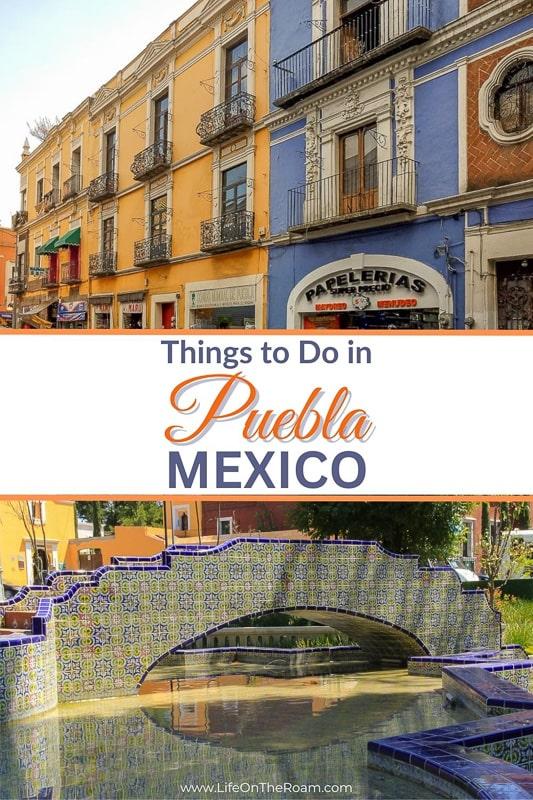
Table of Contents
See the Past and the Present of Art at the Amparo Museum
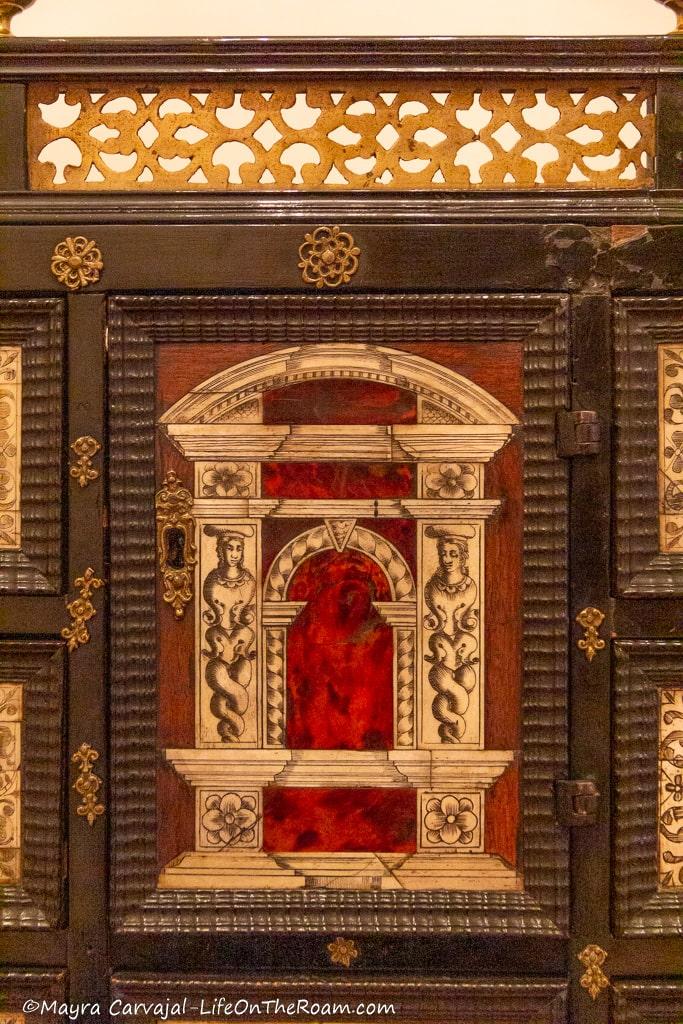
The Amparo museum opened in a 16th century building with an collection that ranges from pre-Hispanic art to contemporary art, including pieces from the vice-regal period to the 19th and 20th century.
First when you come in you’ll see a wall with a comprehensive timeline showing pictures of significant archeological artifacts from 2400 B.C. to 1500 A.D., from Mexico and around the world. Great to see what major cultures were doing everywhere.
This is the appetizer for the main course consisting of hundreds of objects representing ancient cultures across Mexico and pieces from the Colonial era and the 19th century, including painting, sculpture, furniture, and everyday objects used in everyday spaces.
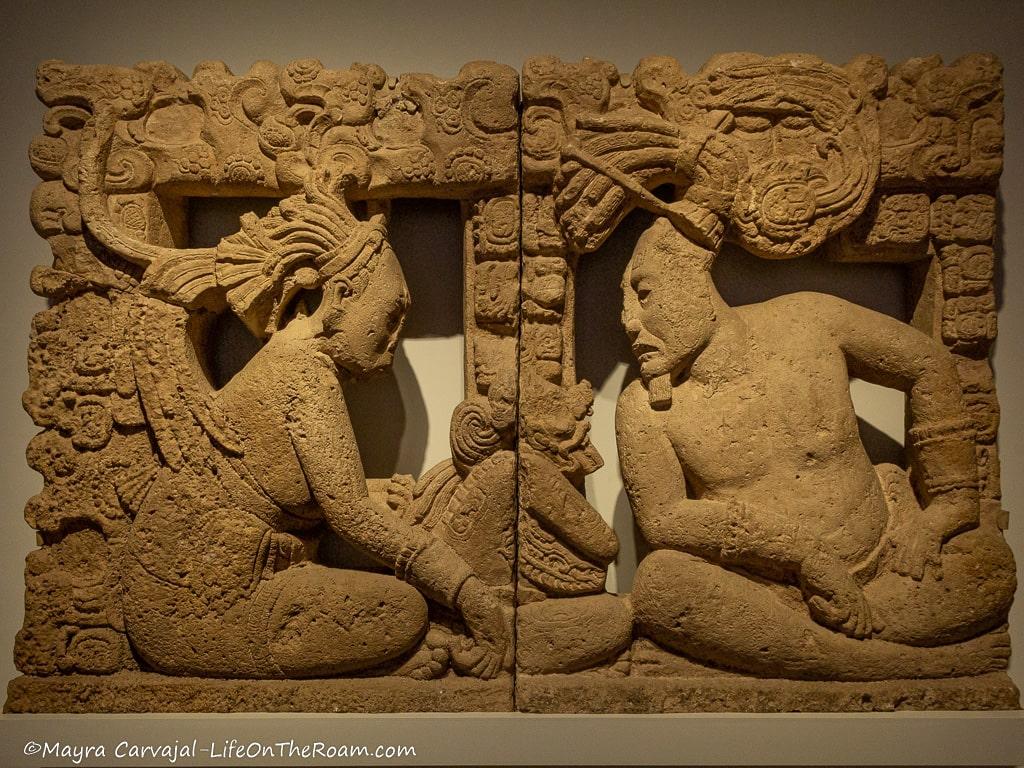
I loved the precious woodwork from the 18th century and the mock-up of a kitchen of a Colonial-era house, with talavera pieces all over.
The last section has beautiful furniture from the early 20th century (don’t miss the desk organizer from Quito, Ecuador, and the painting of Diego Rivera), contemporary art work, and temporary exhibits from local and international artists.
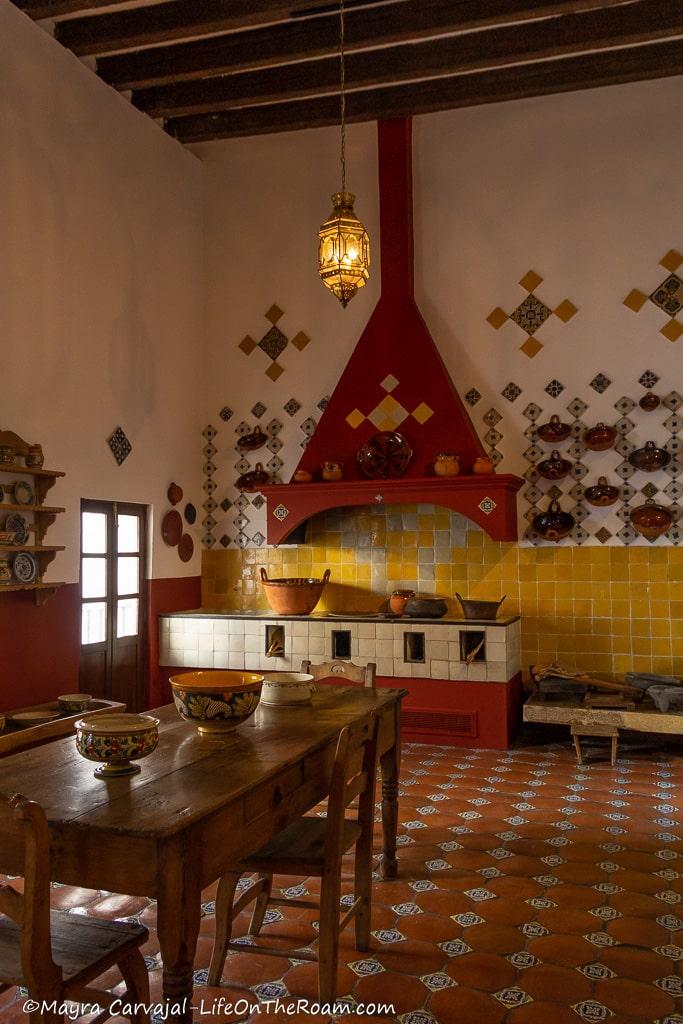
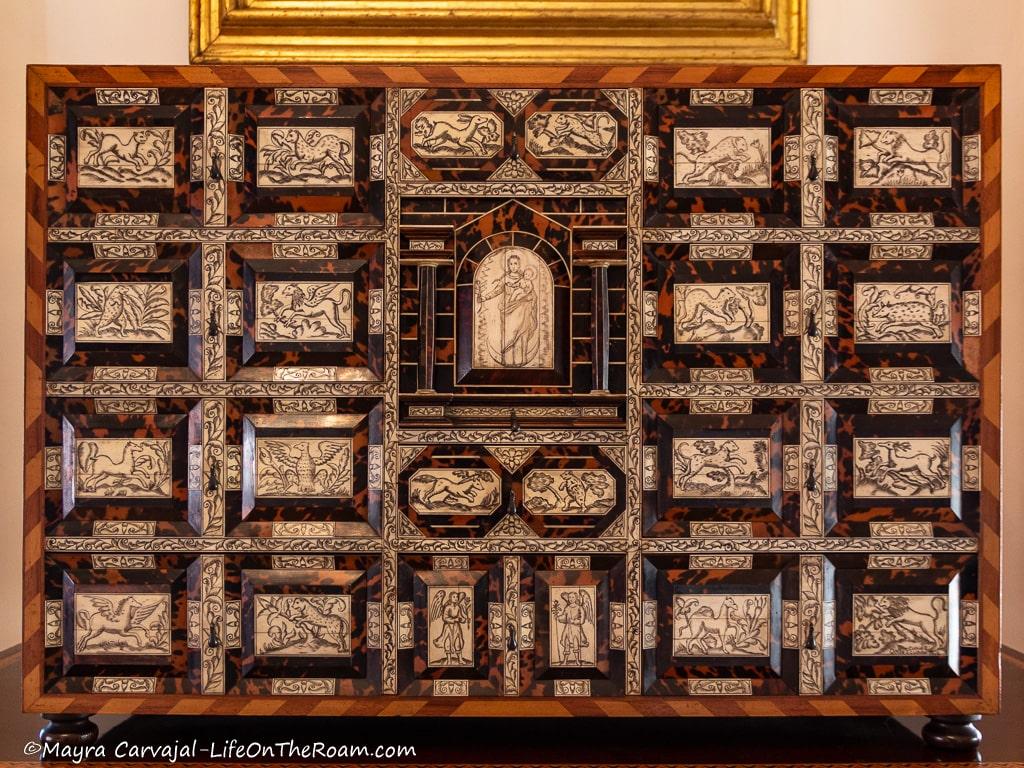
Don’t leave the museum without going to the terrace where you’ll find a café and great views of Puebla’s decorated domes and bell towers, and a distant glimpse of the Popocatepetl volcano.
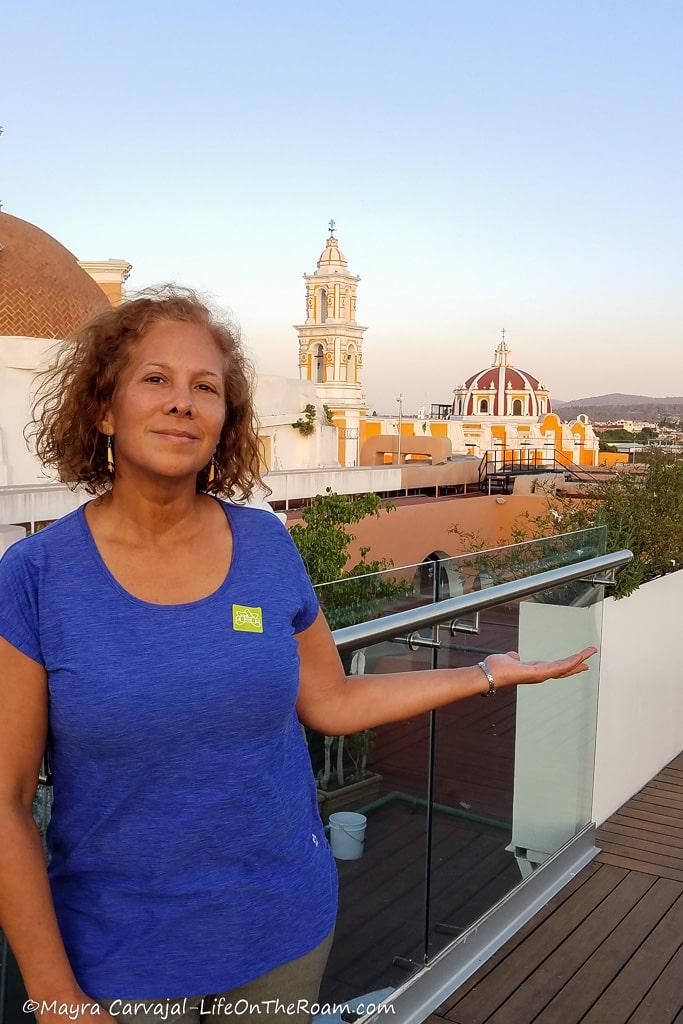
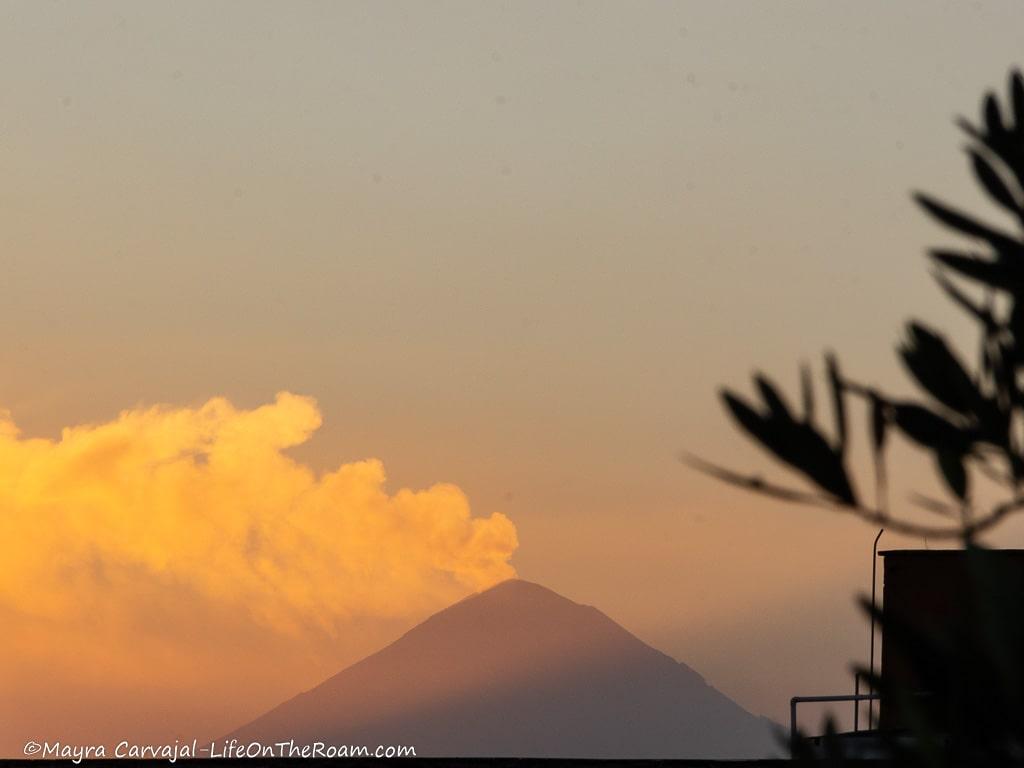
If you’re staying in Puebla and you want a closer look of the Popocatepetl volcano you can take this hiking tour to the Izta Popo National Park, with a 4.9/5 rating based on 40 reviews.
You can also take this hiking excursion to La Malinche, Mexico’s fifth tallest mountain.
Museo Amparo
2 Sur 708, Historic Centre; Open Wed. to Mon.:10AM-6PM; General admission: MXN$ 85 (free admission on Sunday).
Visit The International Museum of the Baroque
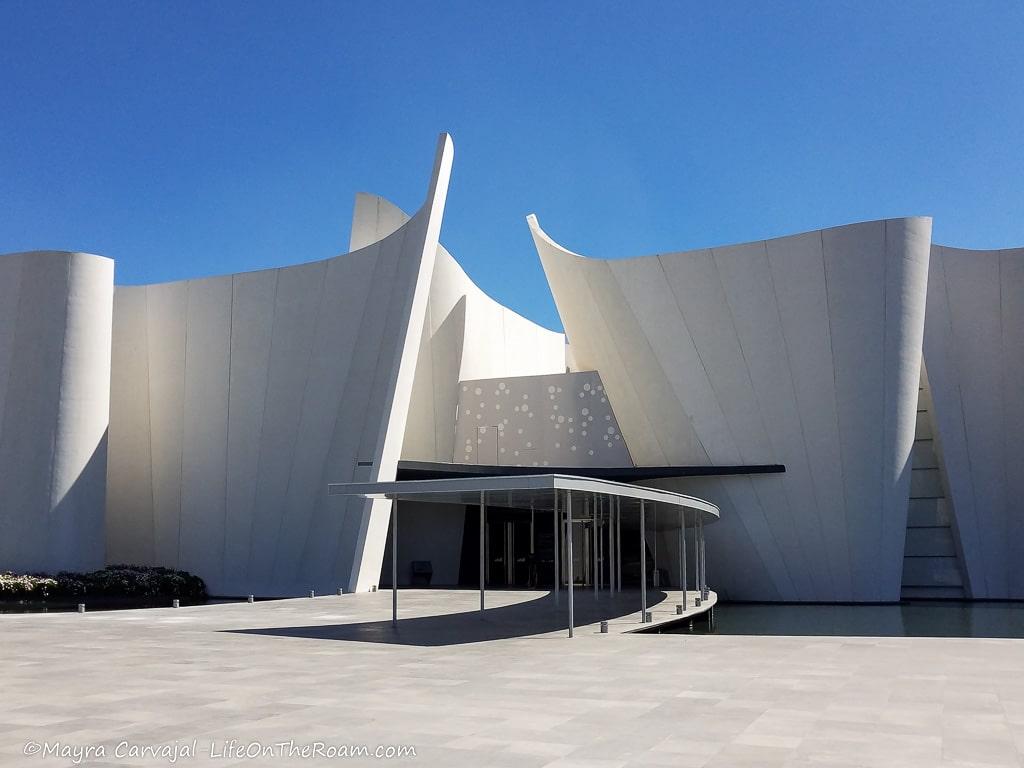
Even from afar you can’t miss the swirly walls of the museum, resembling flying giant sheets of thick white paper. The man behind this masterpiece is Japanese architect Toyo Ito, recipient of the 2013 Pritzker Prize.
Being a fan of all things Baroque I couldn’t be happier to find a museum that celebrates one of the richest periods in the arts during the 17th and 18th century, influencing painting, sculpture, literature, music, dance, fashion, and architecture.
You can see how the Baroque shaped the face of the city of Puebla, with the construction of highly-ornate imposing churches and palaces that screamed “The King is filthy rich! Pick up your jaw from the floor!”.
Check out the lit up scale model of Puebla’s Historic Centre for a birds eye view of the city’s iconic architectural jewels and blown up photographs of its precious details.
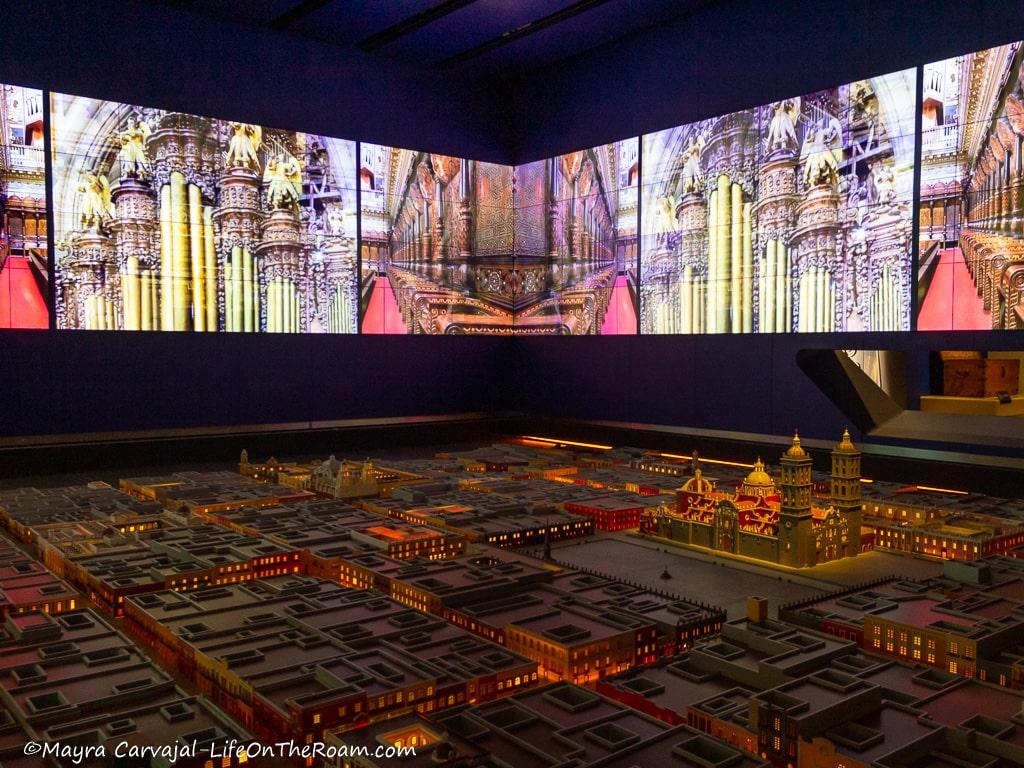
Beyond Puebla, the Baroque dictated the aesthetic of other cities in Mexico such as Oaxaca in the south, Mexico City, and beautiful Guanajuato. Beyond Mexico, on this side of the pond, you can delight in the Baroque style visiting Antigua in Guatemala, Bogota in Colombia, and Quito in Ecuador.
In addition to the display of architectural elements such as carved columns, doors, altarpieces, and corbels, you can find exquisite furniture, and a selection of paintings and sculptures.
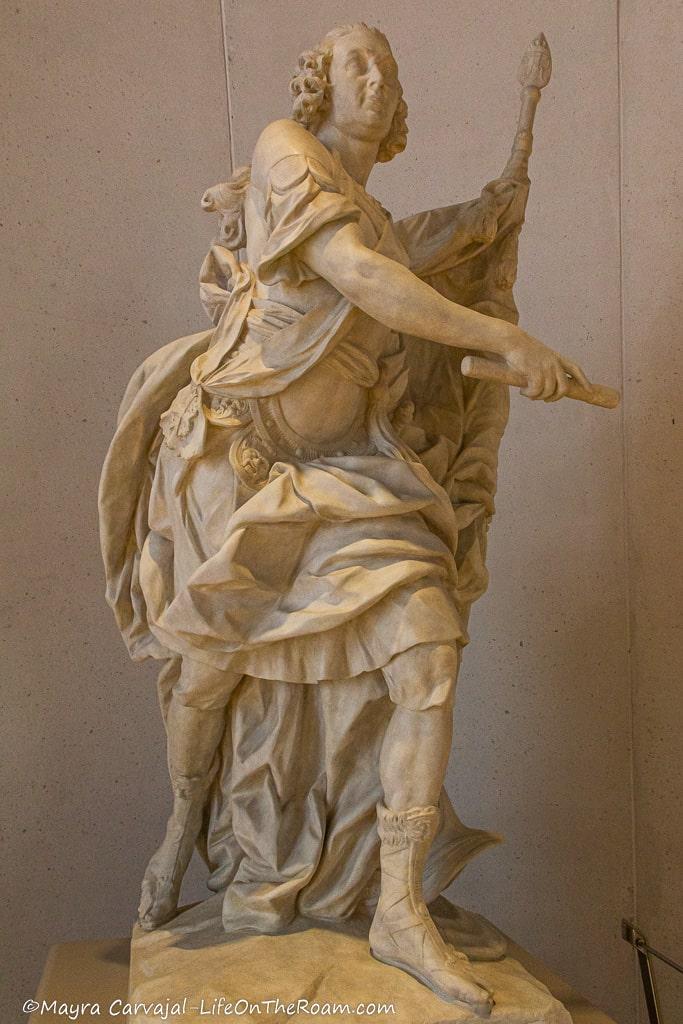
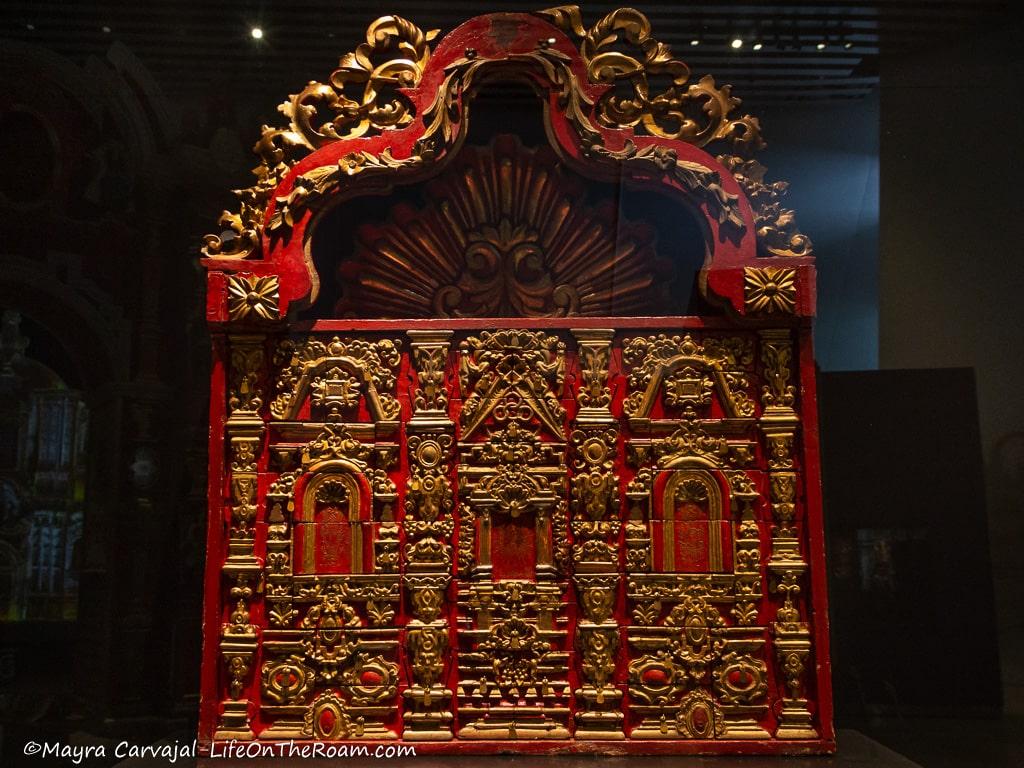
The exhibits are innovative and highly interactive, and use music and video to engage you.
You can sit in a theatre-like setting, learn about Baroque music, listen to an opera, and see the gorgeous costumes worn by the performers. As you make your way through the museum, enjoy the contrast between the complexity of the artwork and the minimalism of the building.
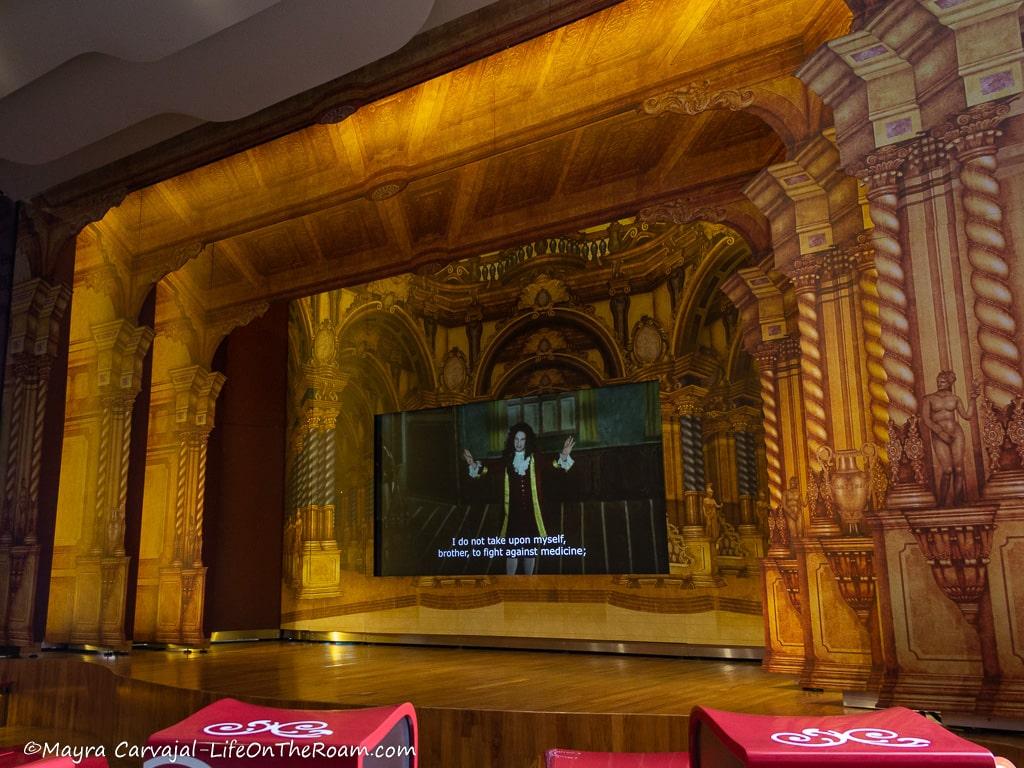
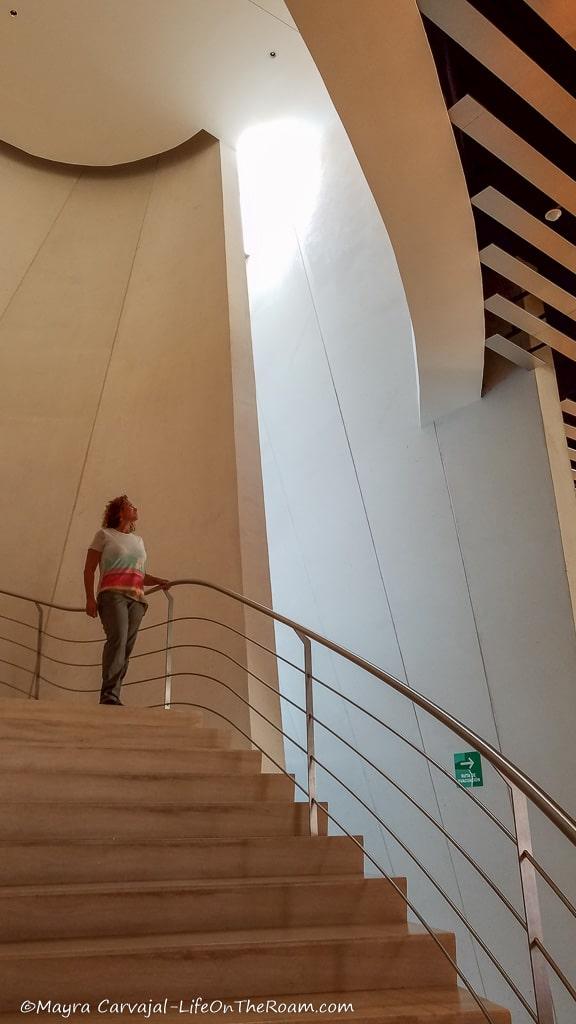
Did you know that the composition of most of today’s music comes from the Baroque period?
Bulevar Atlixcáyotl 2501, Puebla; Open Tue. to Sun.: 10AM-7PM; General admission: MXN$95.
Walk Around Puebla’s Zócalo
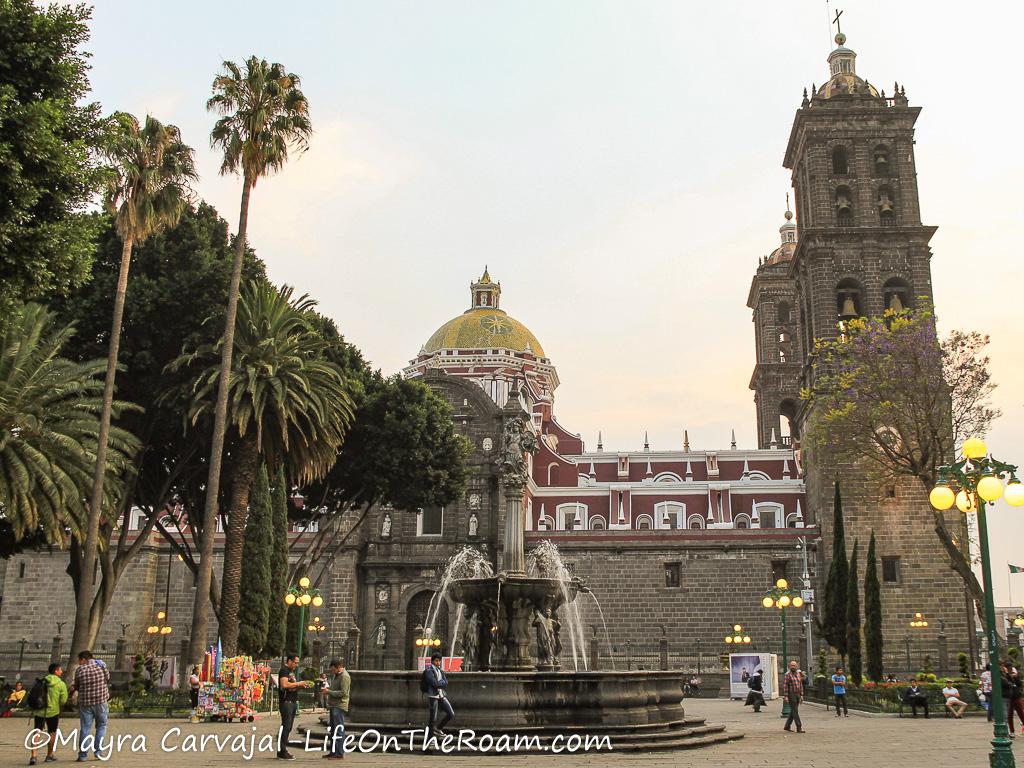
Stroll along mature trees and tall palms in Puebla’s main square, known as the Zócalo de Puebla de Zaragoza, Jardín Principal, or Plaza Mayor de la Puebla de los Angeles.
The zócalo has been the heart of the city since its creation in 1531, establishing the cardinal points used to name the streets of Puebla. Other than hosting important events and being a social hub, it’s home to beautiful fountains, sculptures, and artworks.
At the centre of the zócalo you’ll find the Saint Micheal Archangel fountain, in Baroque style. It has adorned the place since 1777 with Saint Michael Archangel standing triumphantly at the top of a central column overlooking four other angels.
You’ll find many buses around the square offering tours to different parts of the city during the day and at night.
Stop by the Basilica Cathedral of Puebla
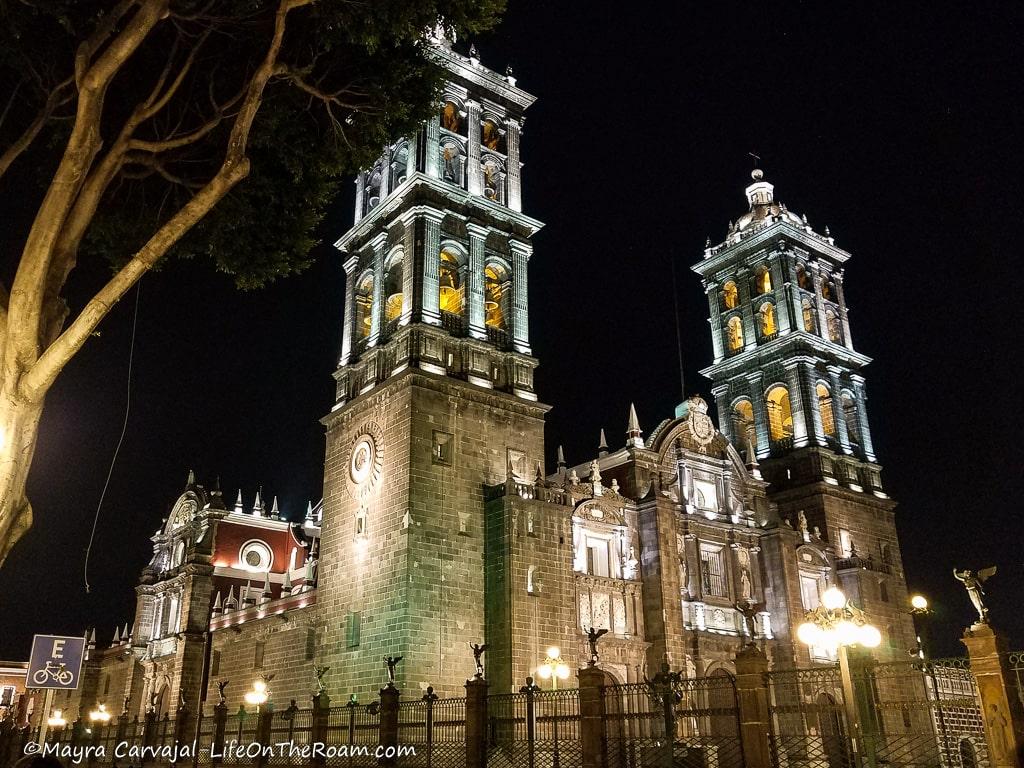
Right next to the zócalo you’ll find the pride and joy of the city: the Basilica Cathedral of Puebla de los Angeles (also known as the Cathedral of Our Lady of the Immaculate Conception), with a rather discrete Renaissance-style façade. It’s the second largest Cathedral of Mexico (after the one in Mexico City).
Its construction began in 1575, but it wasn’t completed with towers and all until 1768. The green quarry stone used to build the monumental towers, extracted from Loreto’s hill (another point of interest in the city), gives them a green tint.
At 74-metre high (242 feet), they’re the tallest bell towers in Mexico, with bells weighing up to 8.5 tons.
The interior of the cathedral brings the wow factor, with a 43-metre high (141 feet) main dome in pumice stone. Doric columns, decorated vaults, paintings, sculptures, woodworking and goldsmithing throughout several altars and more than a dozen chapels will dazzle you.
On weekend nights you can enjoy a video mapping show projected on the facade. This is a not-to-miss in Puebla.
Calle 16 de Septiembre, Historic Centre
WALKING TOUR OF PUEBLA: learn more about the history, culture, and legends of Puebla with this guided tour with a local guide.
Book this tour, with a rating of 4.8/5 based on more than 45 reviews.
Visit the Palafoxiana Library
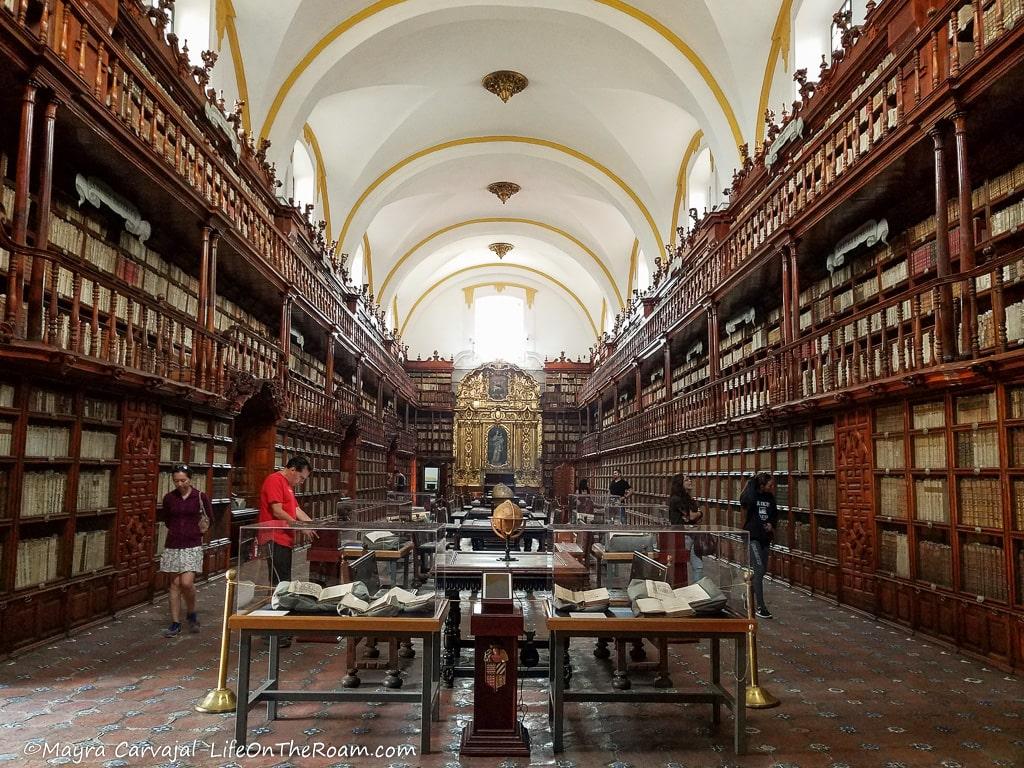
Welcome to the first public library in the Americas, founded in 1646 when Bishop Juan de Palafox y Mendoza donated 5,000 books for its opening with one condition: you didn’t need to be part of the church to have access.
The library was a work in progress for two centuries, becoming one of the largest in the 17th century. Over the years, it collected thousands of books and manuscripts -some of them rare books- and the space under the vaulted ceiling was filled with fine woodwork in Baroque style, flanking a shiny altarpiece.
The oldest book is The Nuremberg Chronicle, from 1493.
What stole my heart was the entrance. The stone carving framing the stunning wood door was my favourite architectural feature. If you, like me, are a fan of beautiful old doors, this will be a treat. Try to go a few minutes before it opens so you can appreciate all the details.
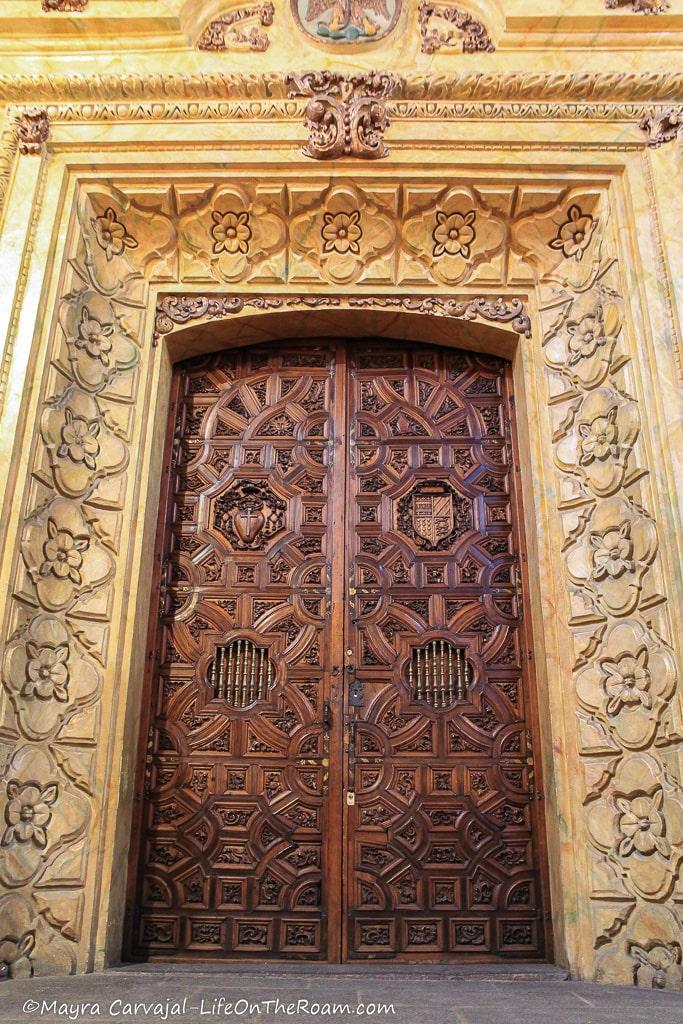
The library is located on the second floor of the Casa de la Cultura, a building with a brick and talavera tile façade that was meant to be the St. John School, and later became a seminary. Here, you can also see rotating art exhibits.
The Palafoxiana Library is registered in the UNESCO Memory of the World program for its outstanding value.
Av. 5 Oriente 5 (2nd floor of the Casa de la Cultura), Historic Centre; Tue.-Thu.:10AM-5PM,Fri.-Sun.:10AM-6PM; General admission: MXN $45 (free admission on Sundays and Tuesdays).
See Puebla’s First Elevator at the José Revueltas Library at the BUAP (University of Puebla)
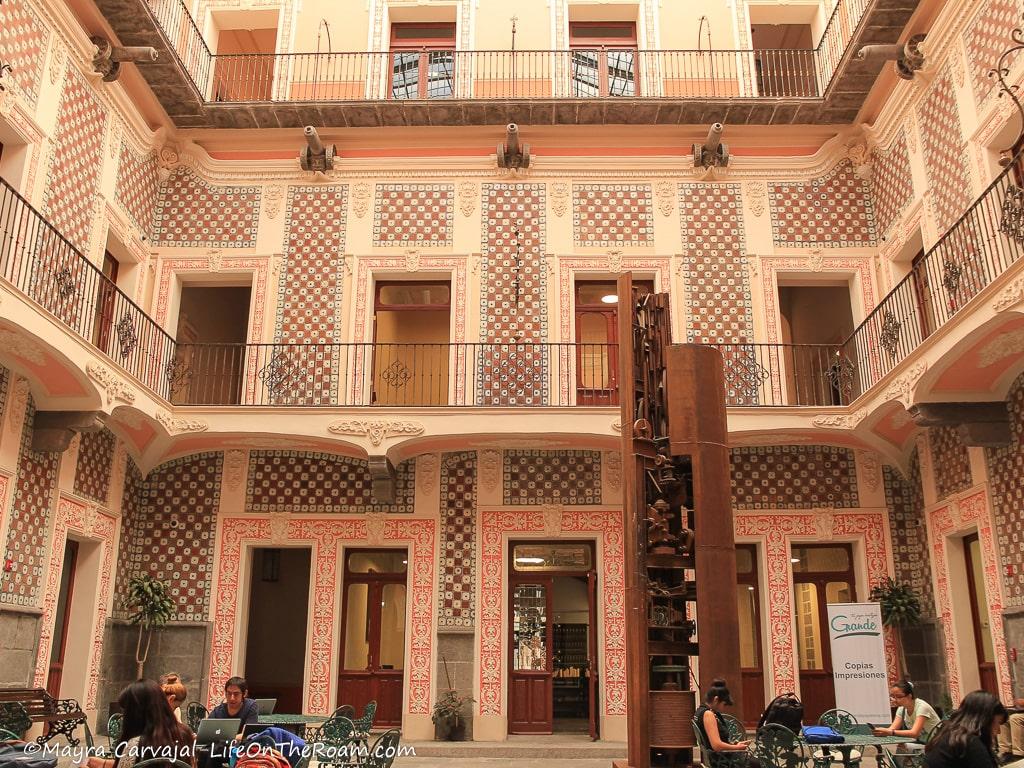
One block east of the zócalo (main square), inside the Arronte Building of the University of Puebla, you’ll find a beautiful courtyard with walls covered in brick and talavera tiles, pink door frames covered with white mouldings. The place is also known as The House of the Canons thanks to its canon-shaped gargoyles.
It’s worth popping in for a few minutes to check out this construction from the 16th century and see the very first elevator of the city of Puebla.
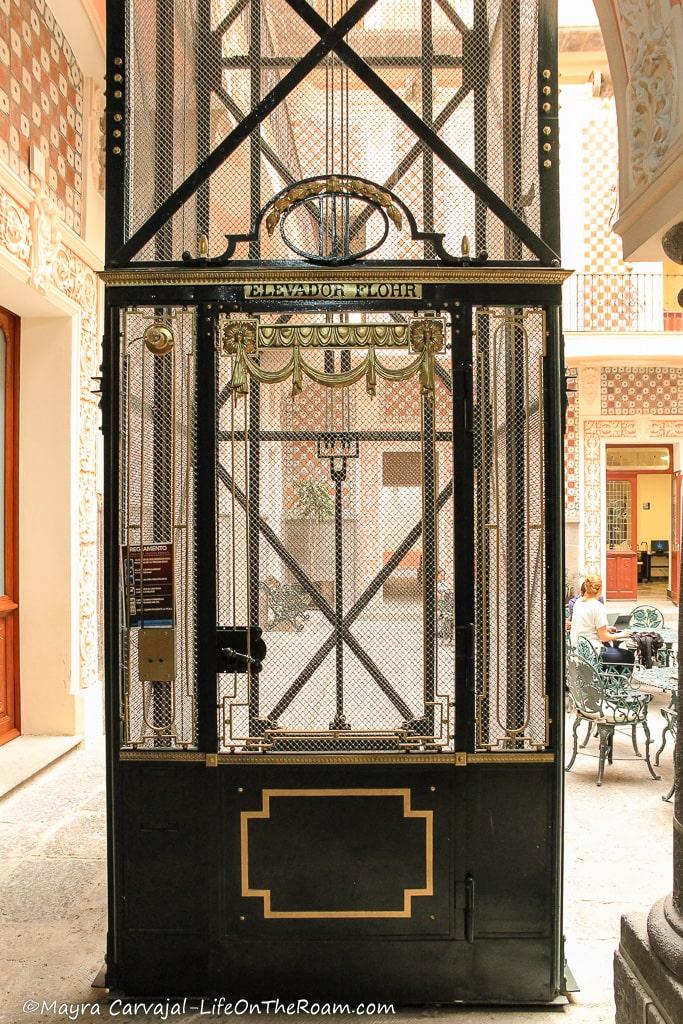
After extensive remodeling the elevator is still working, but not with the original machinery. Artist José Villalobos used the pieces to create the sculpture you see in the courtyard, titled Diacronía.
Av. Don Juan de Palafox y Mendoza 219, Historic Centre
Stand in Awe at the Rosary Chapel in the Santo Domingo Church: Where All That Glitters is Gold
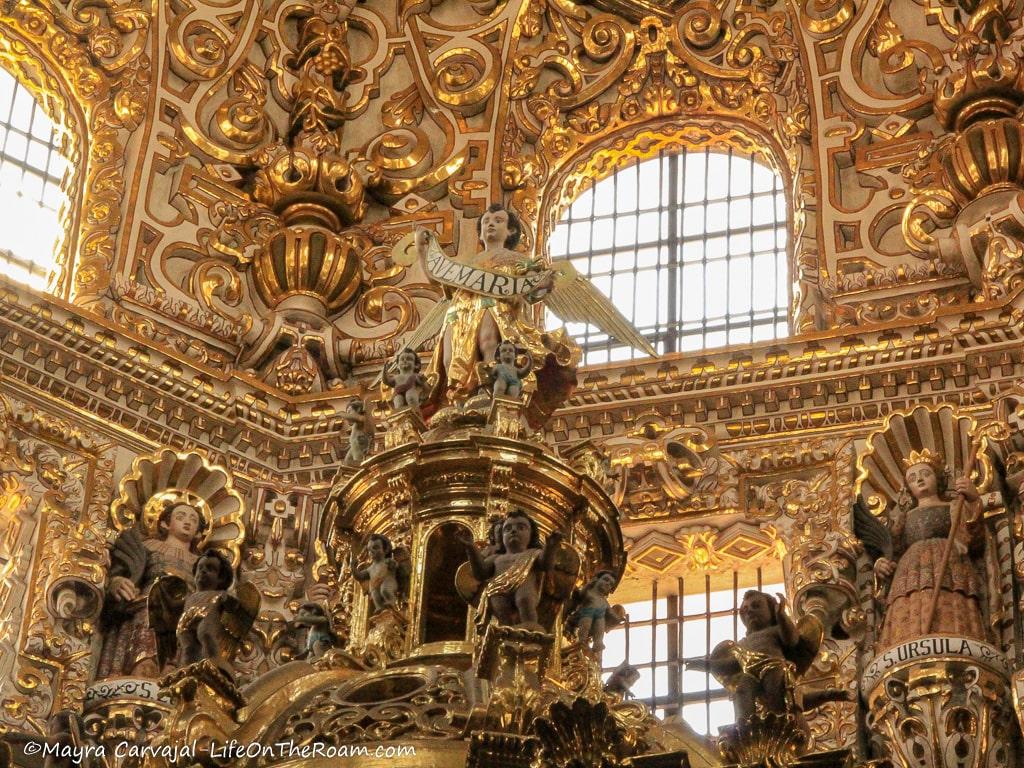
In the 19th century, the church and convent of the Dominican Order (Order of the Preachers) had a massive piece of real estate in Puebla that extended two blocks since its construction started in 1571 and ended in 1659. But then the Reform Laws came, the government took over, and the convent was gone (it became a market).
Only the church survived.
Under a beautiful dome stands the four-story main altar of the main church, covered in gold and packed with elaborate columns and niches with statues of saints, including Saint Domingo -in the centre on the second level- and Saint Francis in blue, right above.
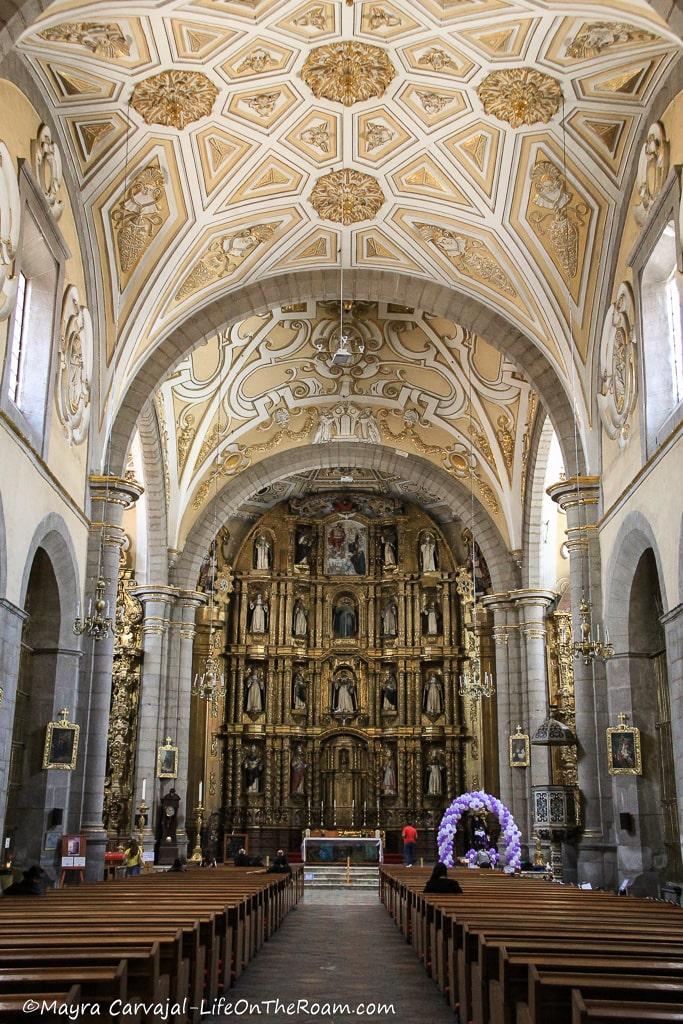
The side altarpieces are even more impressive, but what will make your jaw drop to the floor is the sight of the Chapel of the Rosary.
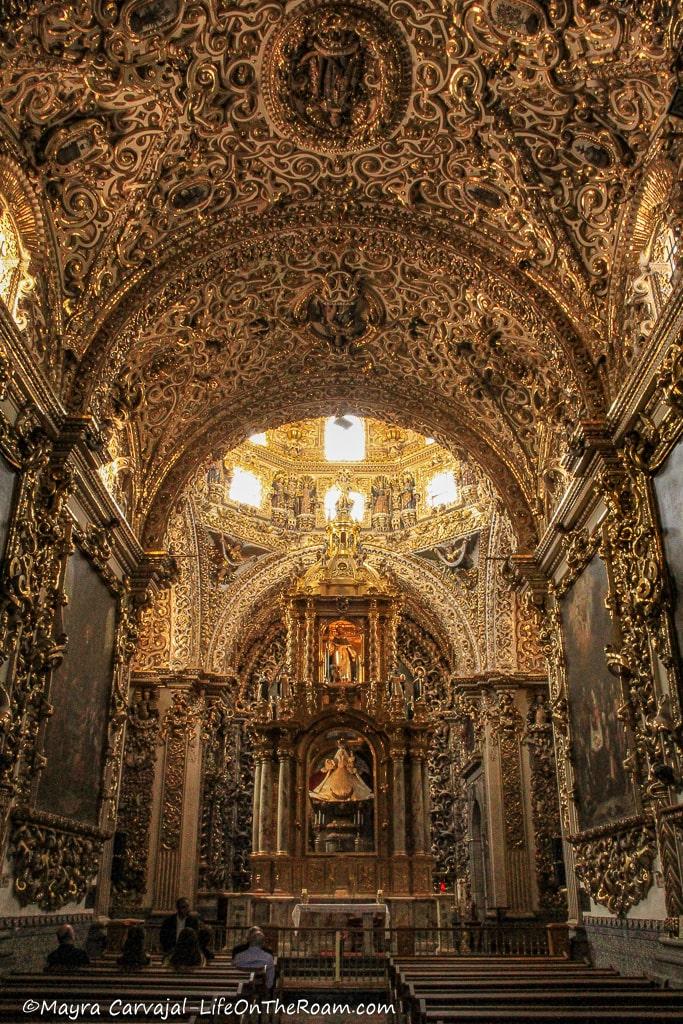
This is the maximum expression of the Mexican Baroque and a textbook example of horror vacui (fear of empty spaces), a defining element of the style. Nearly every inch of this masterpiece is enveloped with paintings, hand-painted talavera tiles, wood carvings, stone, and a beyond resilient stucco covered in 23K gold leaf.
Since its opening in 1690 this chapel, dedicated to Our Lady of the Rosary, has been labeled as the eighth wonder of the new world.
The Lady of the Rosary is also known as the “Queen of the Seas”, which is why you can see a maritime theme in the ornamentation. You’ll find the waves of seven seas in the form of swirls and you’ll see mermaids at the top of the columns.
Look up in the ceiling and you’ll see three medallions in the central arch, with three ladies symbolizing the three theological virtues. The one in the back (at the bottom in the picture), carrying a cross on the right hand, represents Faith. The one in the centre, with an anchor and a crown in the shape of seashells, represents Hope. The one closer to the apse (at the top of the picture), with two kids, represents Charity.
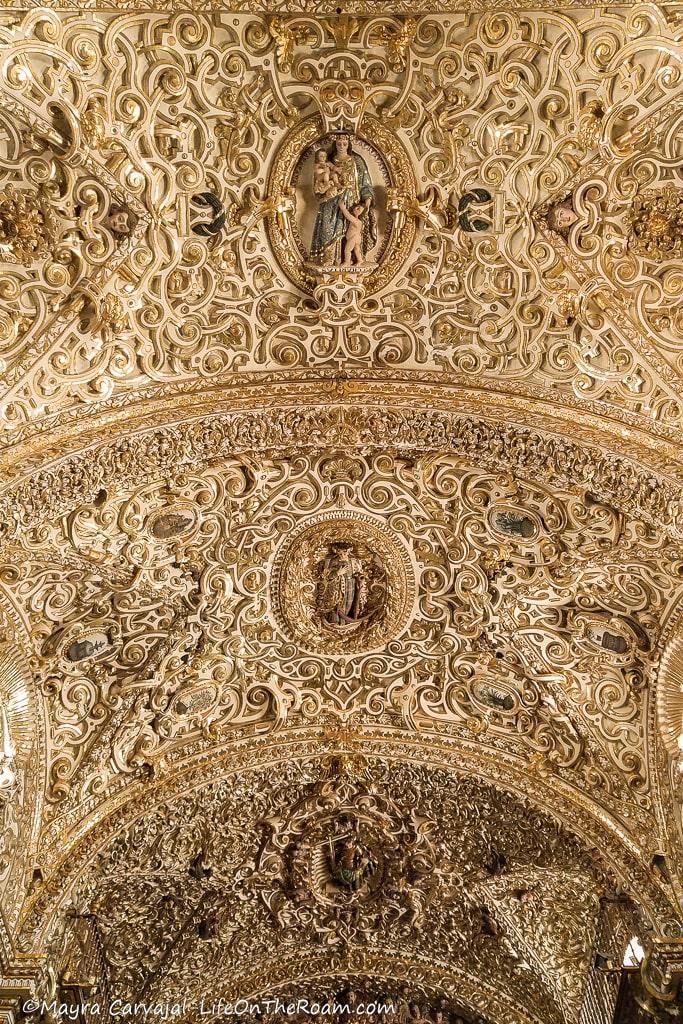
The dome is crowned by a sun-shaped circle with a dove symbolizing the Holy Spirit. Right below you’ll see more ladies in a circle: the Divine Grace is at the bottom, and the rest are the seven gifts of the Holy Spirit. Right below, interspersed in the lower set of windows, you’ll see 16 martyr saints, including Saint Rose of Viterbo, whose temple in Queretaro is a must-see.
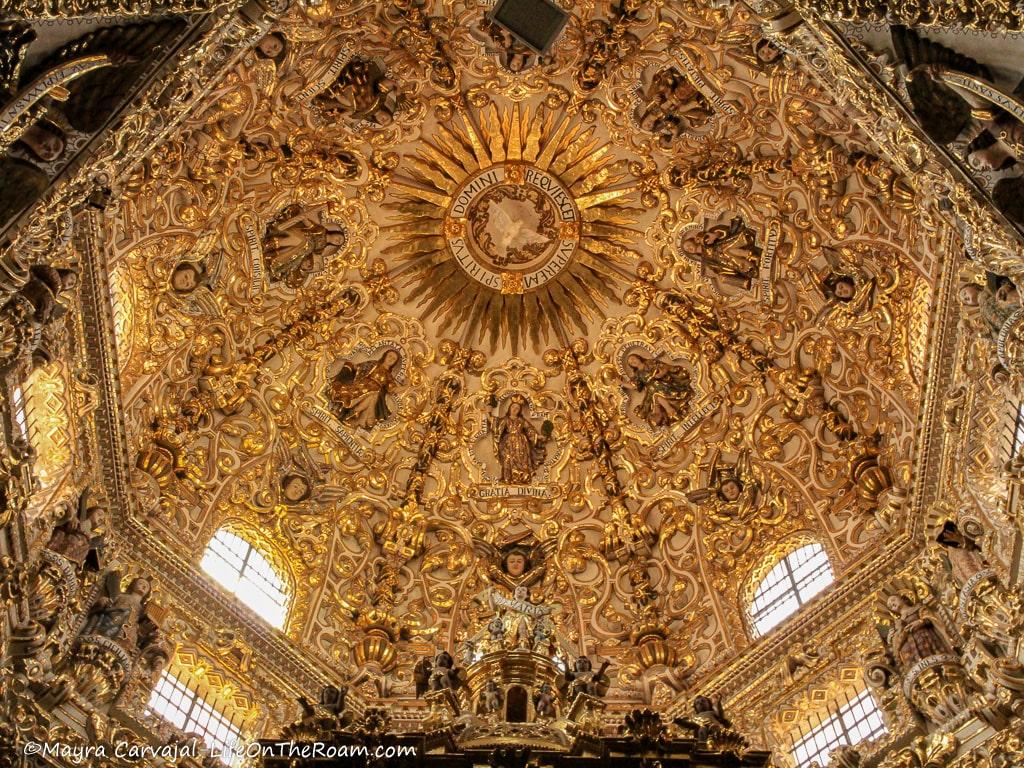
Under the dome you’ll find a baldaquin with 24 columns. On the first level and surrounded by 12 Corinthian columns in marble is the statue of Our Lady of the Rosary, with an elaborate dress made of silk, velvet, and golden threads. She has four dresses that rotate on a monthly basis.
Surrounded by the 12 upper Solomonic columns covered in gold, with floral motifs, is the statue of Saint Dominic de Guzmán, the founder of the order and known as the creator of the rosary. Next to him (and all around the church) you’ll see a dog carrying a torch. According to the legend, it represents Saint Domingo as he was as faithful to God as dogs are faithful to their owners.
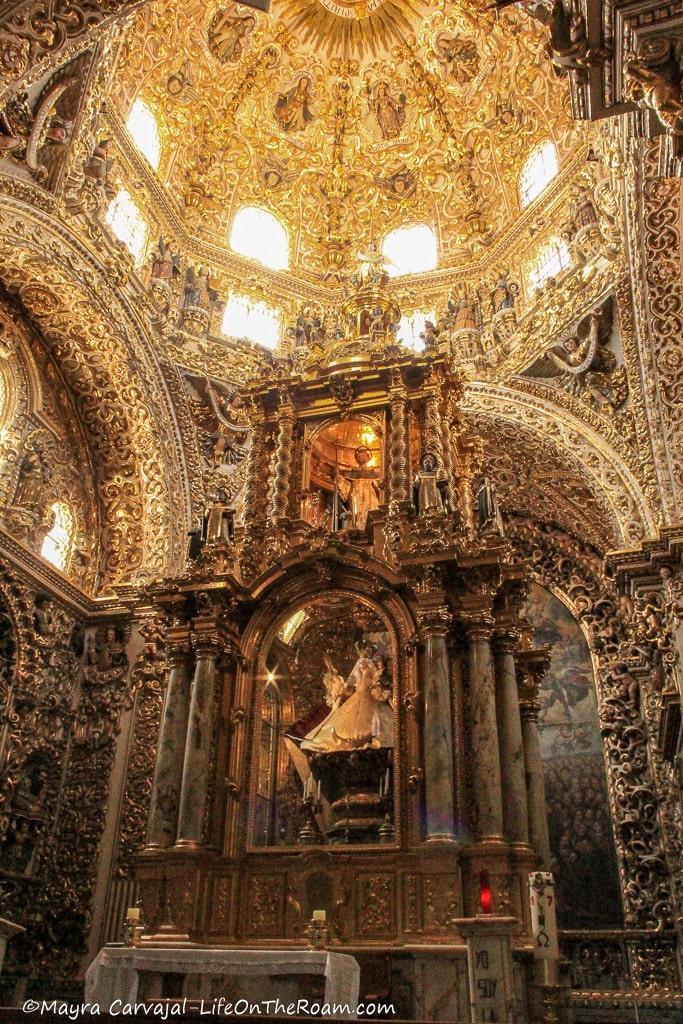
The word Dominican means “The dogs of God”, as in “the faithful servants to God”.
The oil paintings are amongst the first works of Mexican artist José Rodríguez Carnero. He applied the chiaroscuro technique, which is popular in the Baroque style.
Below the paintings you’ll see Puebla’s signature art: the talavera tiles, used for creating a giant rosary around the chapel alternating cherubs with the coat of arms of the Dominican order: a Calatrava Cross (a Greek cross ending in Fleur de Lis). It’s one of a kind in the world.
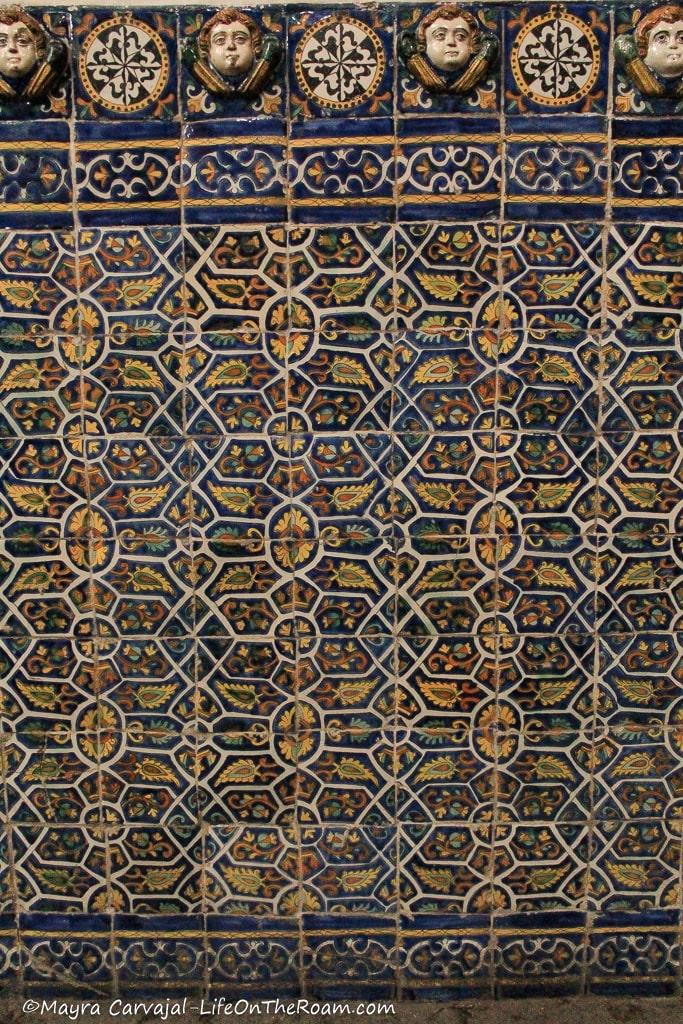
This jewel of the Mexican Baroque is two blocks from the zócalo.
Av. 4 Poniente, Historic Centre
Visit The Holy Spirit Church (La Compañía)
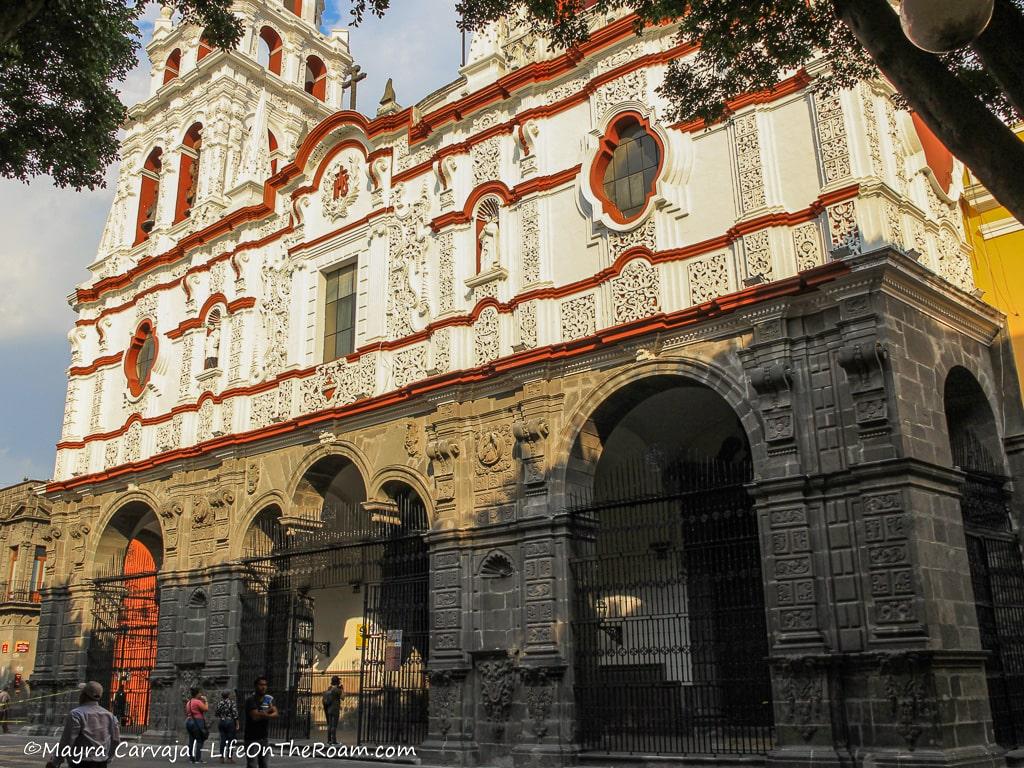
This is version 2.0 of the first temple built on this site by the Jesuit order, featuring two towers and three entrances (a thing reserved for the cathedrals). The most impressive feature is the stone and mortar façade resembling a delicate embroidery, with the coat of arms of the Society of Jesus: the Christogram “JHS” (Jesus Hominum Salvator), meaning “Jesus Saviour of Mankind”.
Calle 4 Sur and Av. Juan de Palafox y Mendoza, Historic Centre
Try the Churros at Puebla La Churrería
Right behind the cathedral you’ll find this heaven of deep fried stuff, including crispy-on-the-outside-soft-on-the-inside churros. Ooh, I loved them covered in cajeta (goat milk candy). And since it’s the most famous churro place in Puebla, there’s always a fresh batch waiting to clog your arteries.
Calle 2 Sur and Av. 5 Oriente, Historic Centre
Taste Traditional Confectionery at La Gran Fama
By 1852 this place was already taking care of all those who had a sweet tooth; it’s the oldest candy store in Puebla. This is an excellent place to try the colourful traditional confectionery that is so pretty that you don’t want to eat it. And it’s delicious too (in moderation as it’s close to 10 on the sugar scale).
The store is pretty too. So much that even if you don’t have a sweet tooth you should stop by to see the displays and the pottery (and the sweets!)
Av. 6 Oriente 208, Historic Centre (more locations listed on lagranfama.com)
Indulge in French Pastries at Dély d’Or
If you’re more into European baking go to Dély D’Or, Puebla’s best French bakery. I love their pâtisserie, it’s superb. They’re a little bit out of the way from the Historic Centre, near the Angelópolis Mall, but they’re so good the trip is 100% worth it.
Search for Antiques and Handicrafts in the Alley of the Frogs (El Callejón de los Sapos)
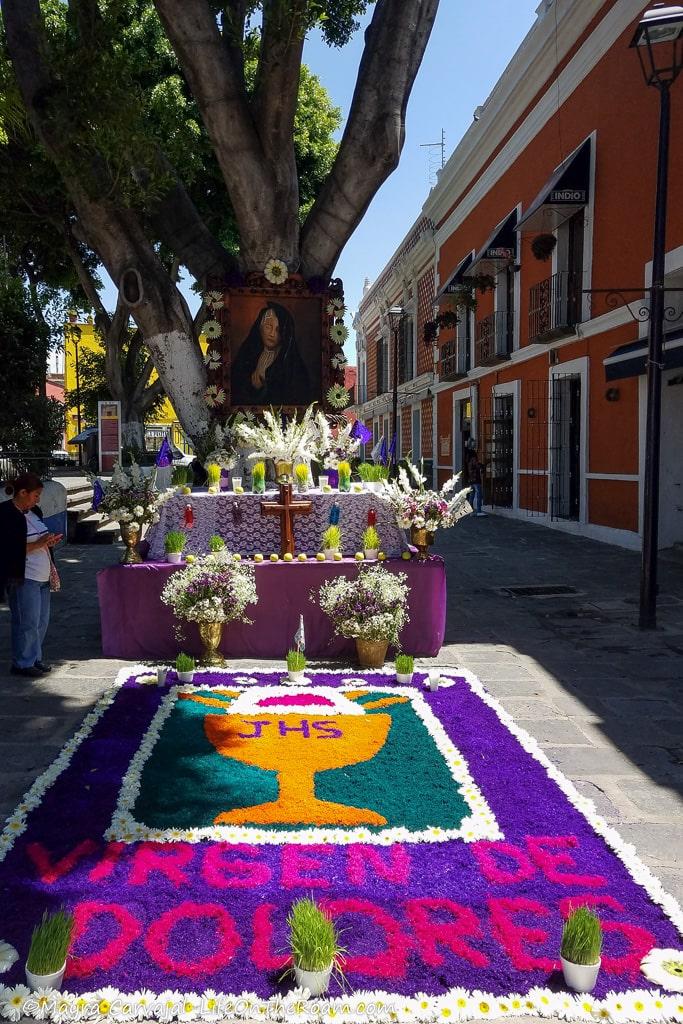
The Alley of the Frogs (El Callejón de Los Sapos) is a tree-lined street where you can find art galleries, antique markets, and furniture and handicrafts made by local artisans. Even if you don’t want to buy anything, it’s worth visiting to see the colourful buildings, the art, and sit in one of the many cafes.
On Sundays you’ll find a big tianguis (an open-air market) and you can enjoy music on weekend nights. The curious name comes from the toads and frogs that covered the square every time the nearby San Francisco river flooded during the rainy season, many moons ago.
Today, the only frogs you’ll find are sculptures, as the river is now a busy road named Blvd. Héroes del 5 de Mayo.
You can stay within half a block of the Alley of the Frogs at this highly-rated boutique hotel:
Casona de Los Sapos Boutique Hotel: all rooms have AC, flat-screen TV, and private bathroom. Some have a seating area and balcony or patio. There’s an indoor swimming pool, a restaurant (some packages include breakfast), a spa and a gym.
Check rates a La Casona, with a rating of 9.4 based on more than 275 reviews.
S
Have a Toast with Pasita at La Pasita

Pasita, as in “small raisin”. This pruny dark sweet dried fruit is used to make an artisanal liqueur named pasita. Stop by La Pasita bar (quenching the thirst of its customers since 1916) and taste the traditional drink, served with a small piece of goat cheese, and a raisin. You can also try other drinks with some hilarious names.
The place is a window to the past as it hasn’t changed much since it opened more than a century ago and it has many antiques on display. It’s like having a drink on the exhibit floor of a museum.
Av. 5 Oriente 602, Historic Centre
Find Real Talavera Pieces at Barrio del Artista
Real as in artisanal talavera pieces that are made following the traditional methods established in Puebla in the 16th century.
The talavera (along with the mole poblano) is what Puebla is best known for. You’ll recognize it when you walk across the city and see it on buildings, and when you see the shiny hand-made pottery objects with geometric and organic patterns, with blue and white as the main colours, but sometimes combined with green, yellow, orange, and red.
The Spaniards brought the majolica technique and taught it to the local artisans, who created pieces with the natural clay from the region, and added their own twist. The result is a unique art that has earned a Protected Designation of Origin Certificate. No piece made outside the region of Puebla can be called talavera.
An authentic talavera piece is of high quality and comes with a certificate. And it’s expensive. If you’re paying big bucks for the real thing, make sure it is as there are many imitations.
You’ll find several factories at the Barrio del Artista and the area nearby, as well as in the city of Cholula, less than one hour away . Some factories offer tours so you can see the fabrication process.
If you make it here you can also visit El Parián Artisan Market where you’ll see plenty of handicrafts.
You can stay near this artsy district in a highly-rated five-star hotel:
Hotel Boutique Casareyna: spacious suites in a 17th century house with a restaurant, an outdoor swimming pool, and an art gallery. All rooms have AC, WiFi, a desk, and flat-screen T.V.
Check out Casareyna, with a rating of 9.3 based on more than 1,225 reviews.
Go to Analco’s Street Market
Three blocks east of El Callejón de Los Sapos is Analco, one of the oldest neighbourhoods of Puebla and home to the largest tianguis (street market) of the city where you can find crafts, antiques, hand-made jewelry, and a variety of local delicacies. The market, which has been going on for centuries, is open during the weekends, but Sunday is when all stalls are open (and there’s more food).
Parque Analco, Calle 10 Sur 301, Barrio de Analco
Bonus tip: if you’ve made it all the way here, walk two blocks north and check out the Angel Custodio (The Guardian Angel) on the Blvd. Héroes del 5 de Mayo. The 17-metre high, bright yellow iron sculpture by Enrique Carbajal (a.k.a. Sebastián) isn’t on the list of Poblano’s favourites, who have given it all sorts of less than flattering names. In addition to taking issue with its shape (can you see the angel?), they weren’t happy with its cost and financing. They also think it clashes with the aesthetic of the city.
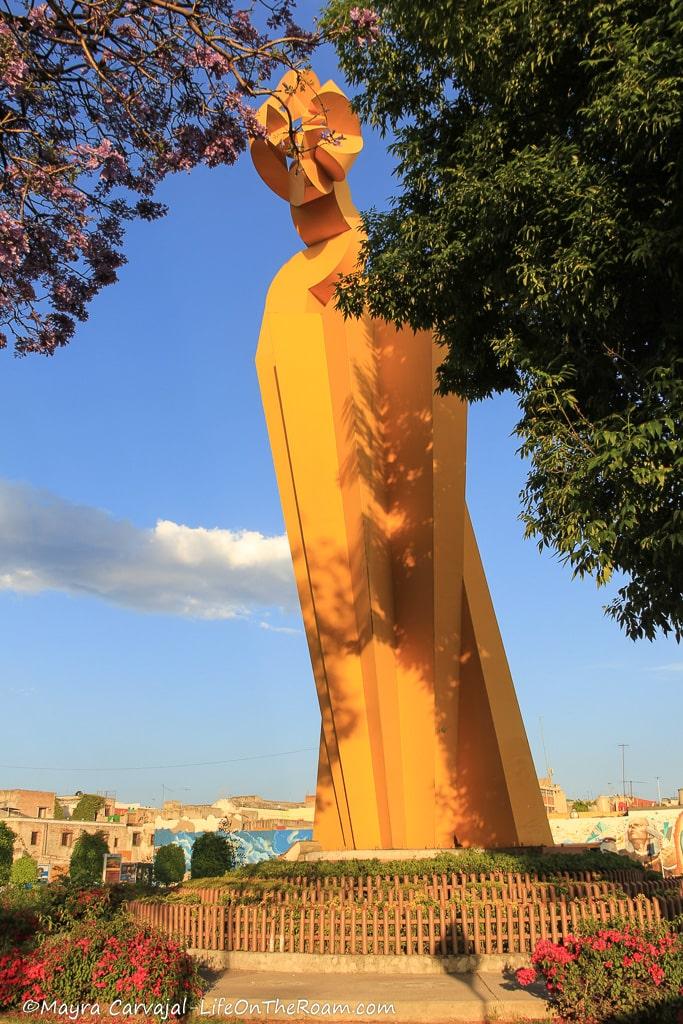
What do you think? Do you like it? Whether the answer is yes or no, an interesting thing is that under its base there is a chest with letters written by Poblanos with their hopes for 2031, when Puebla turns 500 years old. The chest will be opened then to see how close or how far they are from reaching them all.
Visit the Church and Ex-convent of San Francisco
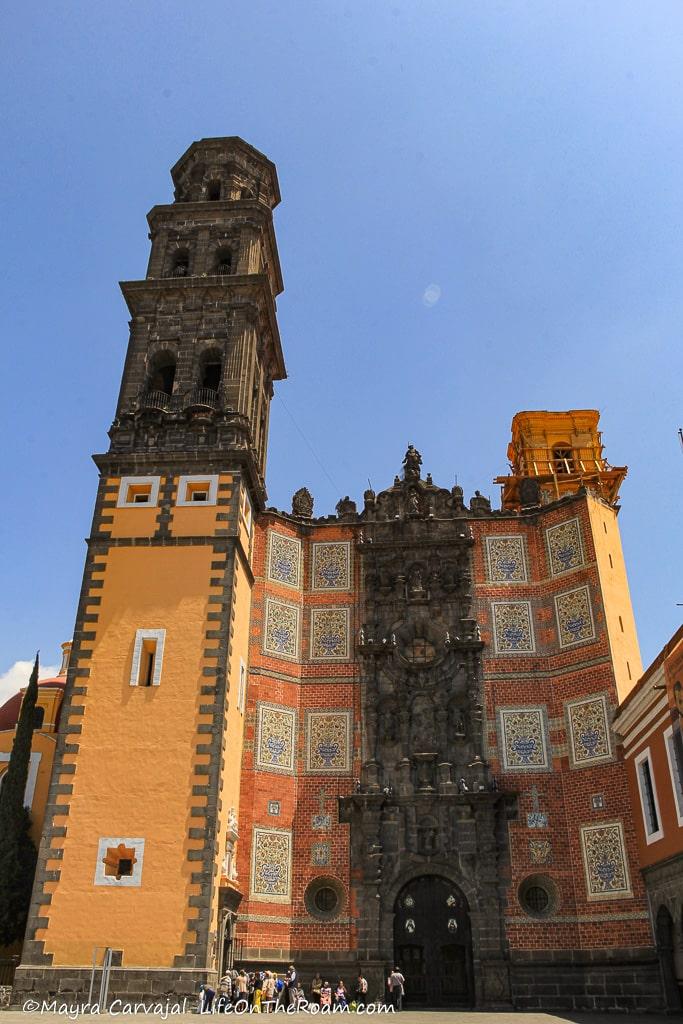
This is the first Franciscan convent in Puebla and one of the first convents in the city. When Puebla was founded in 1531, the official mass for the event was celebrated near the grounds of the complex, which today functions as a school, a library, and a remaining church with valuable relics for the Catholic Church.
In my opinion, the most beautiful part of the church is its façade in Baroque style, completed in the 18th century. The central section has an intricate design in stone and it’s flanked by panels in talavera tile with floral motifs, surrounded by bricks.
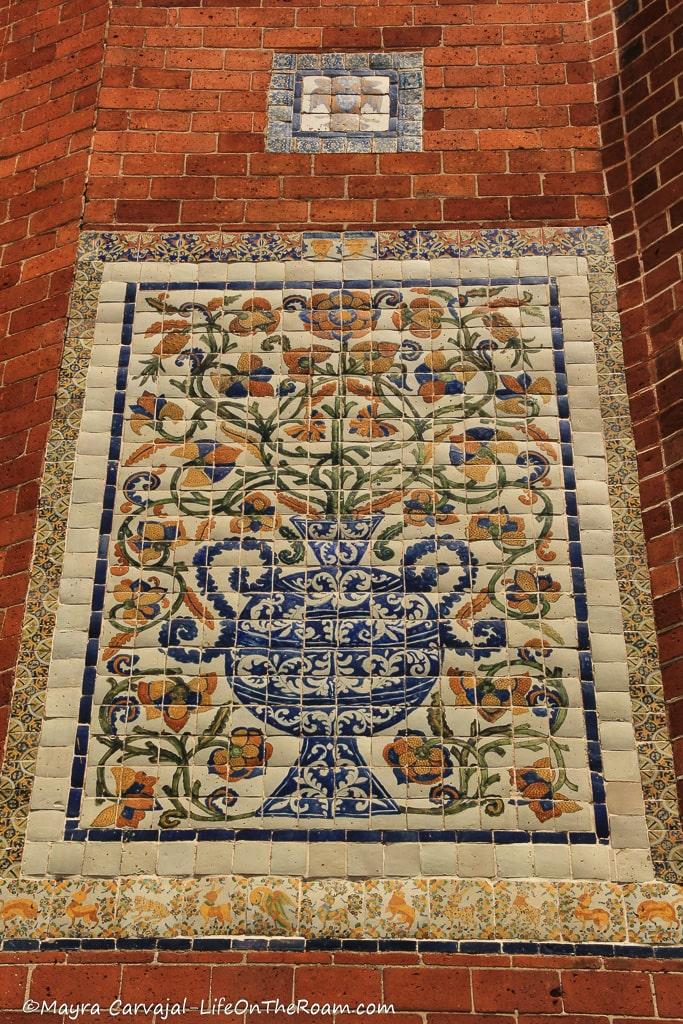
Av. 14 Oriente 1009, Barrio del Alto
See the Talavera Mosaic in the Fountain of the Lions (Fuente de los Leones)
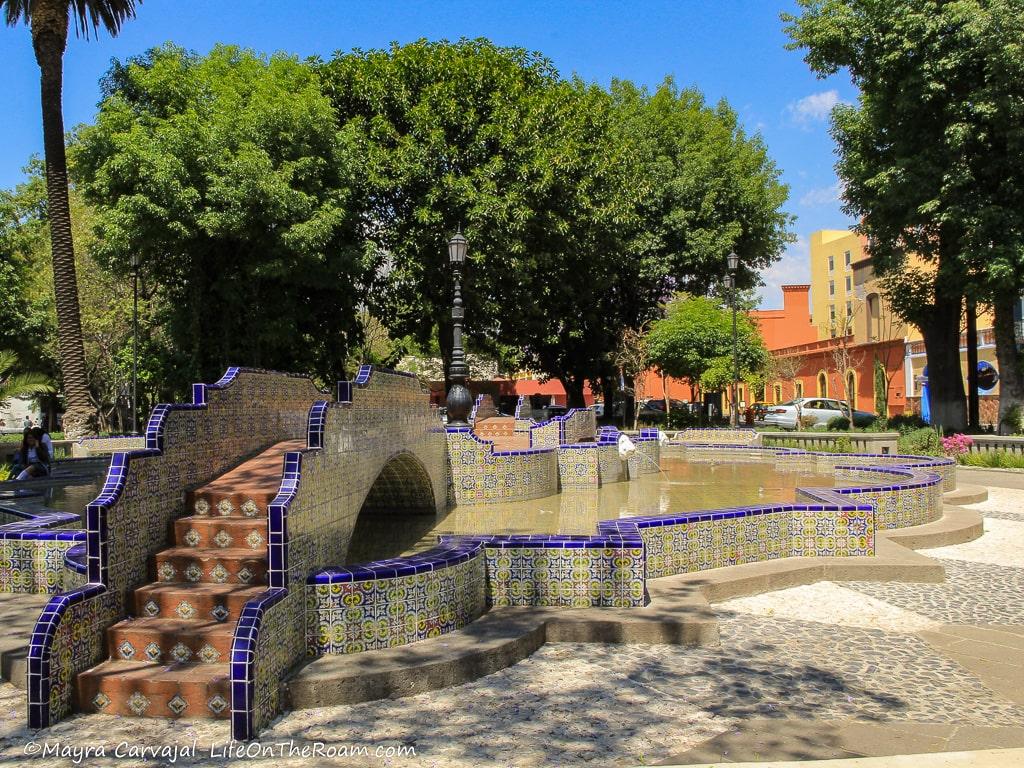
Across the San Francisco church you’ll find a cute midsize park where the main attraction is a moorish-style fountain with connecting bridges built in the early 1940s. The Fountain of the Lions is a work of art thanks to the talavera tiles that cover it. Following Puebla’s tradition, blue is the dominant colour in the ensemble, but green, yellow, and orange touches create a vibrant composition.
Walk under the shade of big trees to the north section of the park to find some circular benches covered in mostly green and yellow talavera tiles.
Calle 10 Norte and Av. 14 Oriente, Barrio del Alto
You can stay right next to the park and be welcomed by the fountain when you arrive at this trendy 5-star hotel, across the beautiful church of San Francisco:
Banyan Tree Puebla: enjoy a garden and a terrace with an outdoor swimming pool and a fantastic view. All rooms have a seating area, flat-screen TV, WiFi, AC, a minibar, and some have balconies. Some packages include breakfast.
Stay at The Banyan Tree Puebla: with a rating of 8.9 based on more than 330 reviews.
Travel Back in Time at the Almoloya Wash-house (Lavaderos de Almoloya)
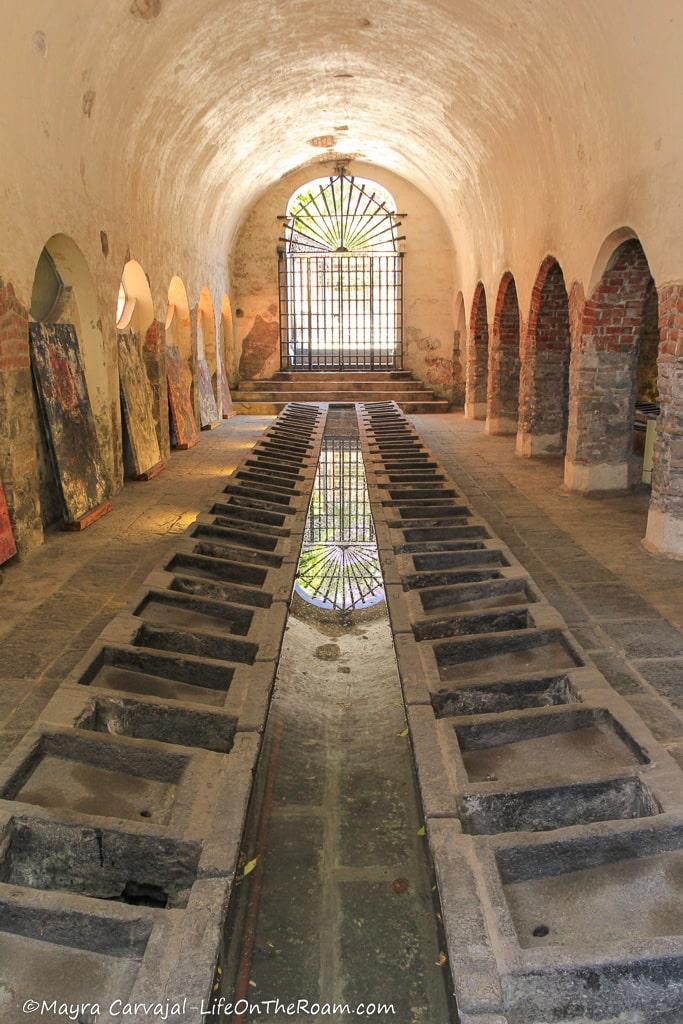
A few steps east of the Fountain of the Lions, on Calle 10, you can stop by the Almoloya wash-house, a piece of Puebla’s history where laundresses gathered in the 19th century.
Where did they go before? To river sources, springs, and lakes, far from the city centre. And they weren’t happy. Just imagine carrying loads of dirty, bulky clothes for miles, washing them in the woods where they had to make the soap (no Tide pods back then), and bringing them back to the city without a stain.
Something had to change and the government started building wash houses near running water. But the Almoloya wash-house, built after 1863, was the most famous and with the juiciest gossip.
Almoloya is the original name of the San Francisco river, which ran through what is now the 5 de Mayo Boulevard.
Calle 10 Norte (east of the Fountain of the Lions), Barrio del Alto
Walk the Underground Tunnels Used for Puebla’s Battle of Cinco de Mayo
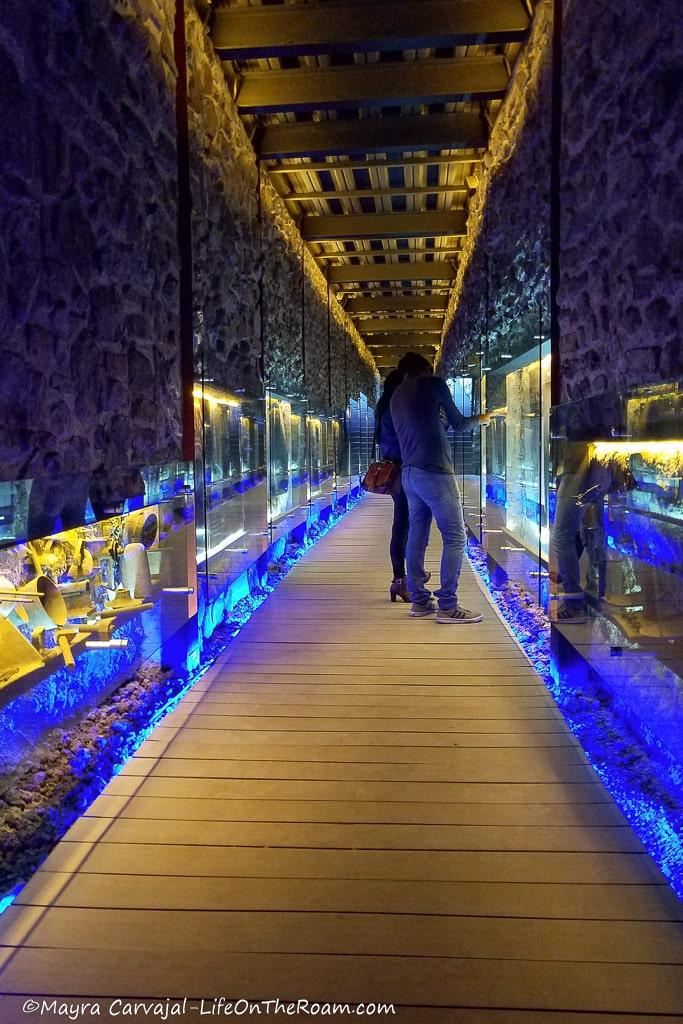
Allegedly…at least that’s what archaeologists think so far.
What is known today as the Historic Passage 5 de Mayo is a 477-metre tunnel (0.3 miles) that runs under the Xanenetla neighbourhood, ending at the Loreto Fort. But historians say it may extend for more than 10 kilometres (about 6 miles), and it may be around 350 years old.
The stories told by the objects excavated from this segment say that construction workers used these tunnels to carry supplies to build Puebla City in the 17th century.
Monks stepped on the same path where soldiers marched on their way to the trenches and to the Loreto and Guadalupe Forts.
The route is divided in six sections, with signs (in Spanish) describing the artifacts displayed along the way.
Some of the taller and wider sections, like the one below, were used for horses and carriages as they connected the Zaragoza cavalry to Xanenetla.
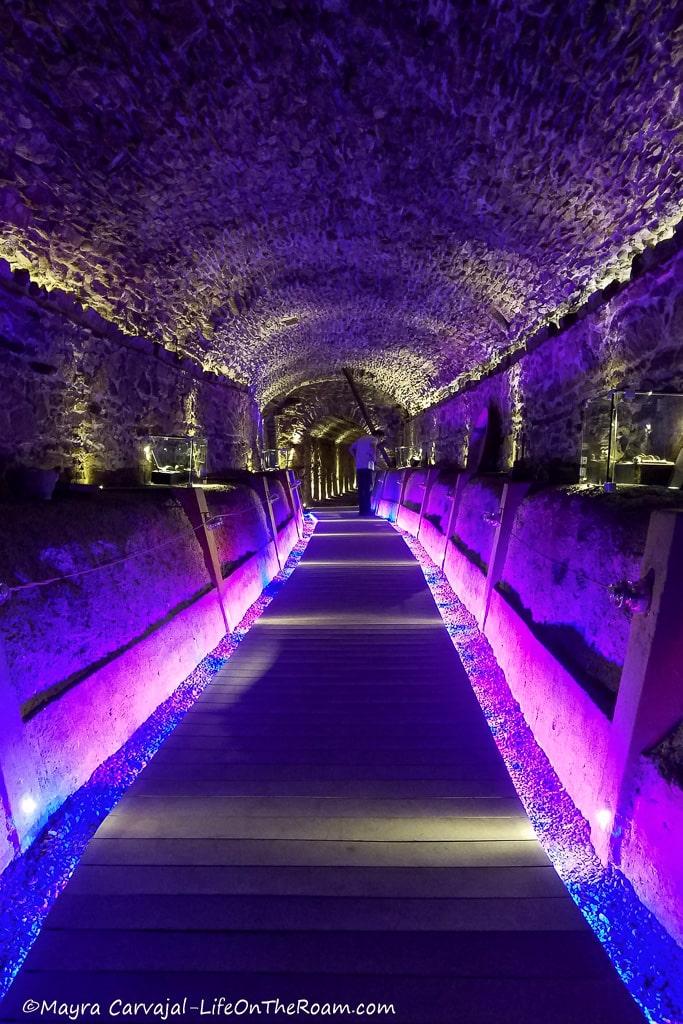
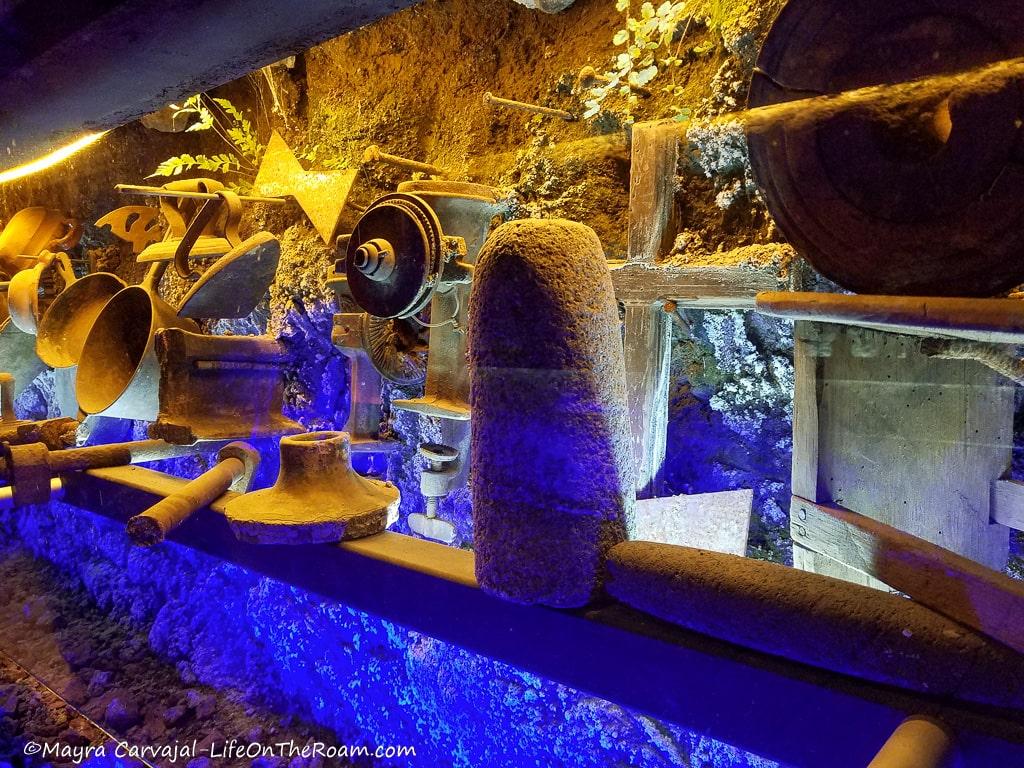
The excavations have revealed that other sections may have been used to deliver and store ammunition and to care for wounded soldiers.
Towards the end of the passage you’ll emerge from what may have been the tunnel exit used by the Mexican army to fight the French army in the Battle of Puebla on May 5th, 1862.
Note: most people (outside Mexico) assume that they’re toasting to Mexico’s independence when they eat tacos and have tequila shots on May 5th. Cinco de Mayo is not about Mexican independence, it’s about the Battle of Puebla and their (temporary) victory against the French Army.
On the last section you’ll walk above the trenches where soldiers waited for the command to fight the enemy in the Loreto fort.
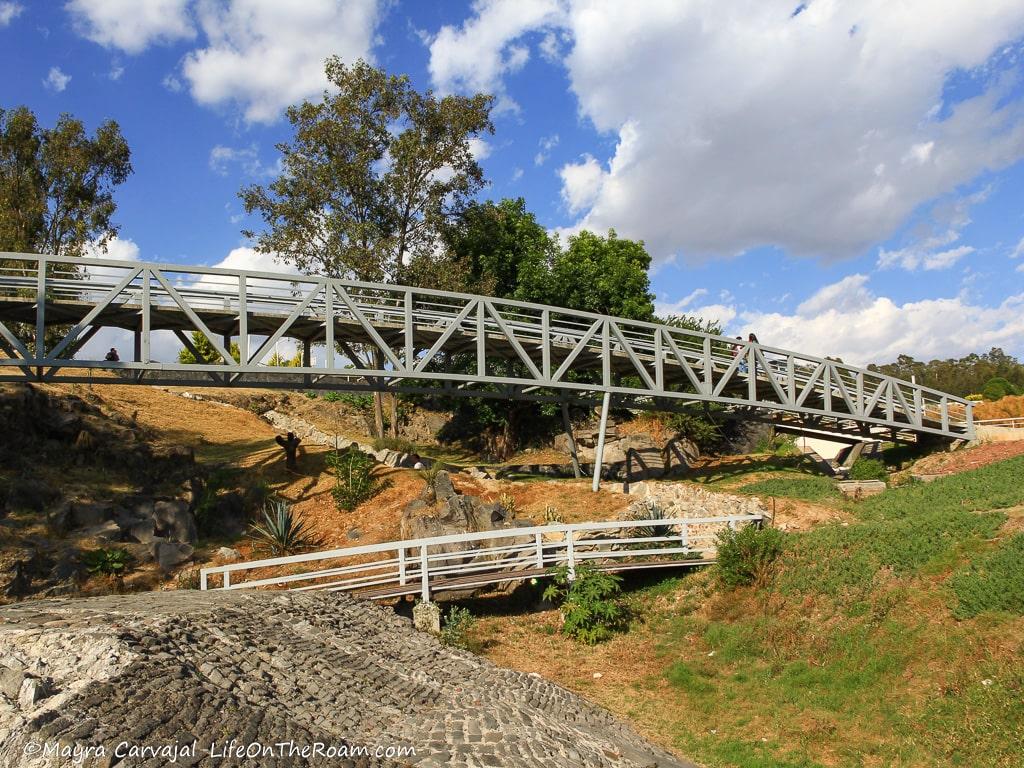
The exit takes you to La Concordia Park, where you can enjoy a nice view of Puebla.
Blvd. 5 de Mayo Oriente No. 208, Barrio de Xanenetla; Open Tue.to Sun.8AM-4PM; General admission: MXN$27
Enjoy a Panoramic View of Puebla at the Parks in the Fort Historic District
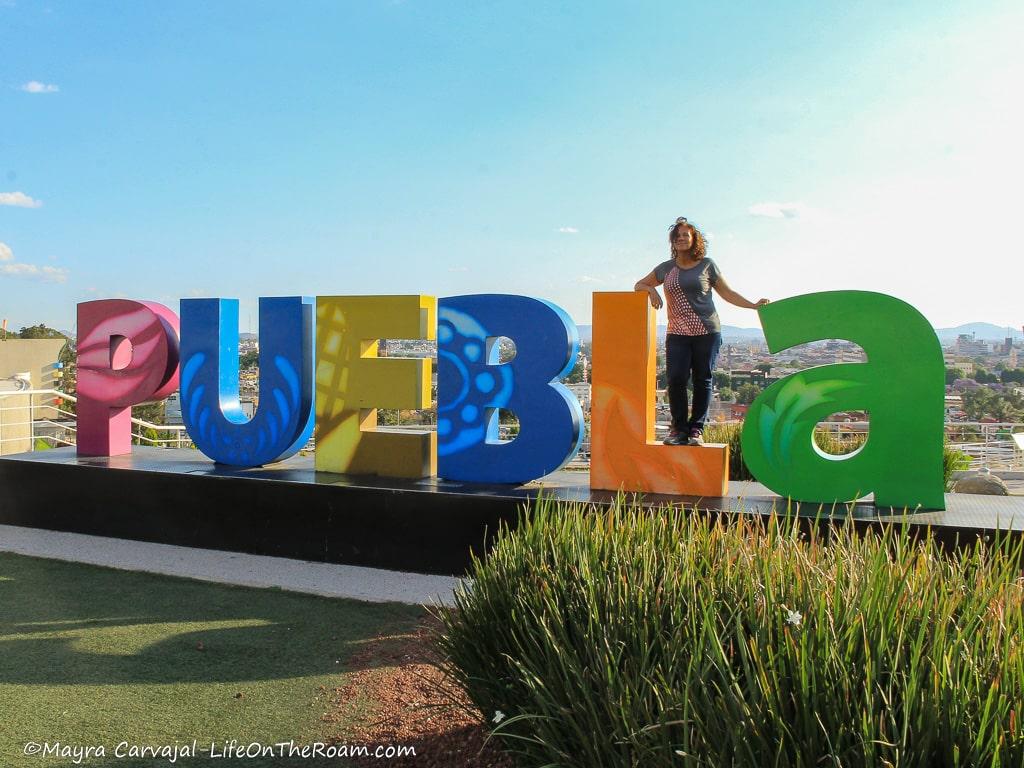
Take a tour bus or a taxi to the hill where the Loreto and the Guadalupe Fort overlook Puebla City to find several small parks and lookouts interconnected by paths, making it a good place to relax outdoors and have a drink watching the mountains in the distance.
This is also your exit point if you do the Historic Passage of 5 de mayo.
From La Mantarraya lookout you too can overlook the city, strike a pose next to the Puebla sign, rent a pedal boat to go across Lake Concordia and watch the ducks run for their life from children behaving like animal-loving Elmyra.
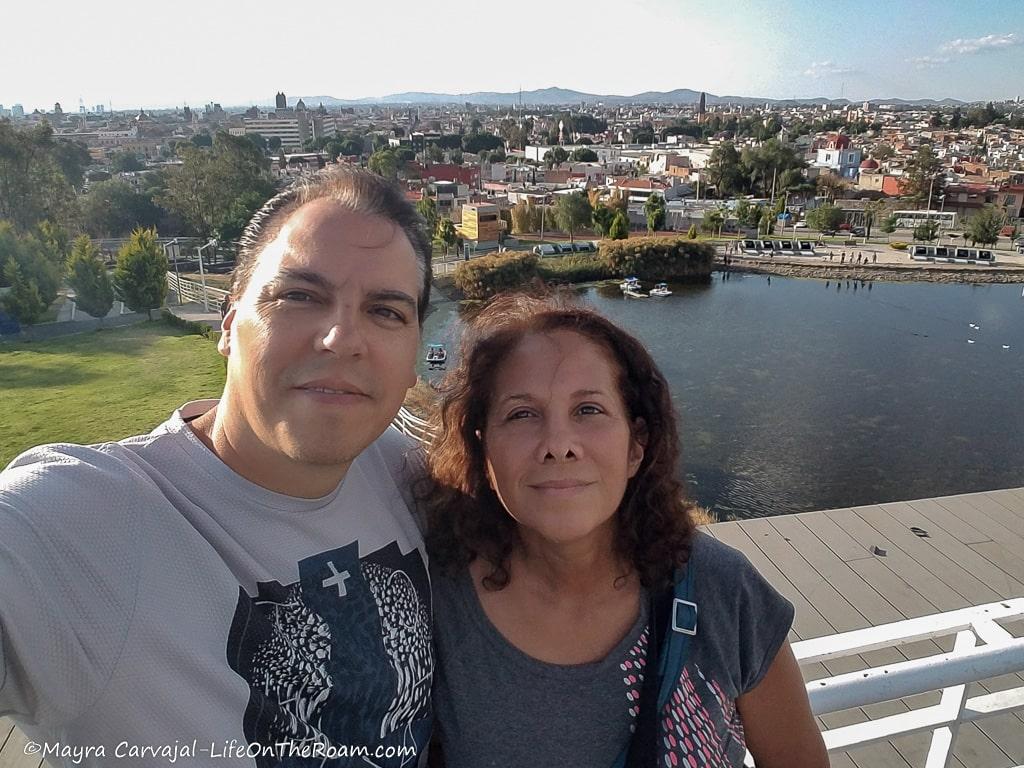
On the northeast section you’ll find the 5 de Mayo Theme Park (Parque Temático 5 de Mayo) where the path takes you through models depicting the traditional cultures in the state of Puebla, as well as models referencing historic events and used for parades in the city.
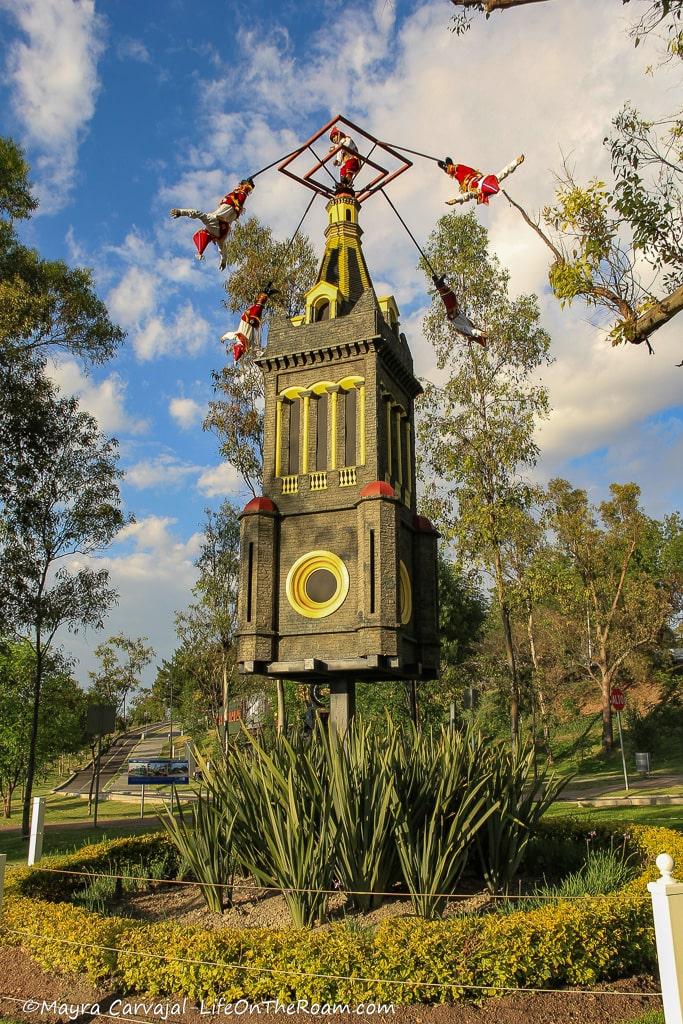
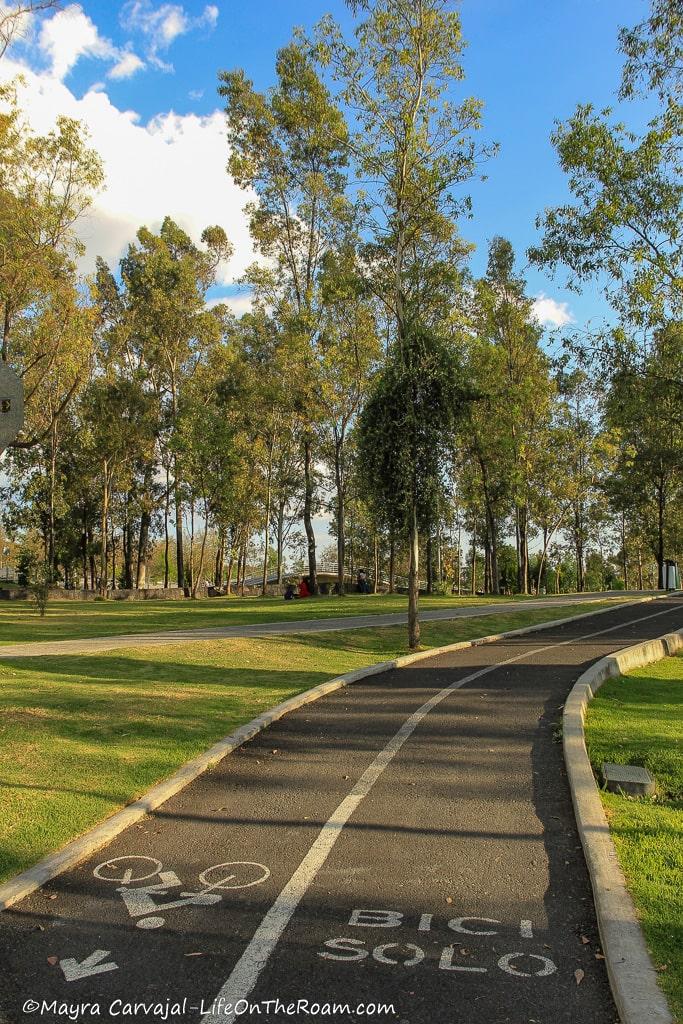
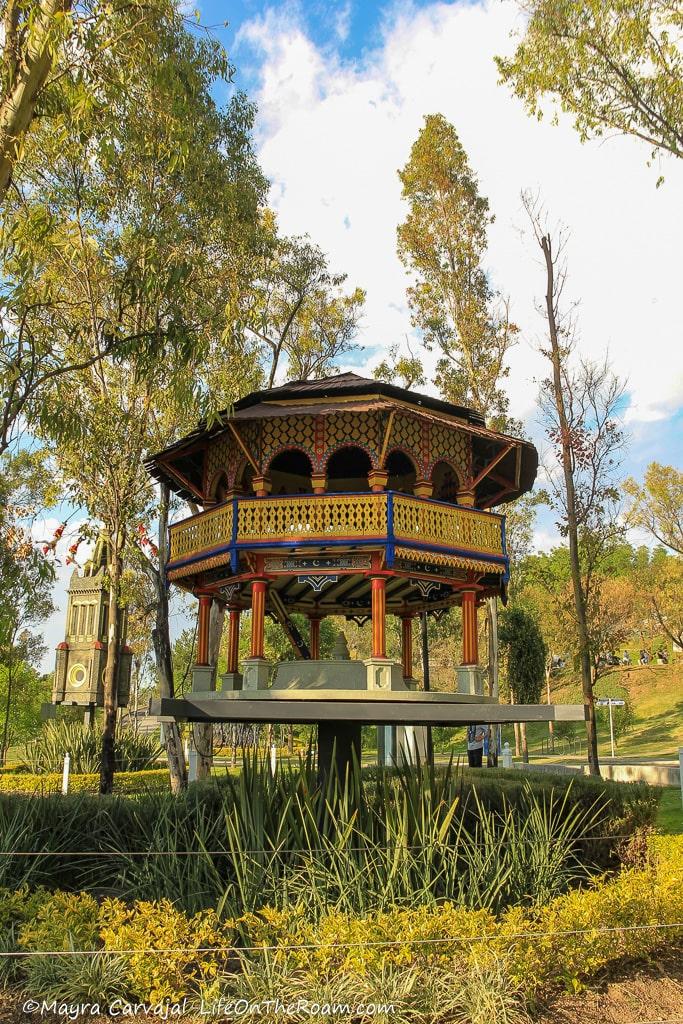
There’s also a planetarium, an exhibition centre, and several museums.
If you want to have an even higher point of view you can take a short ride (688 metres -0.4 miles) in the cable car (teleférico).
See Puebla’s Murals in Xanenetla (But Read First Before You Go)
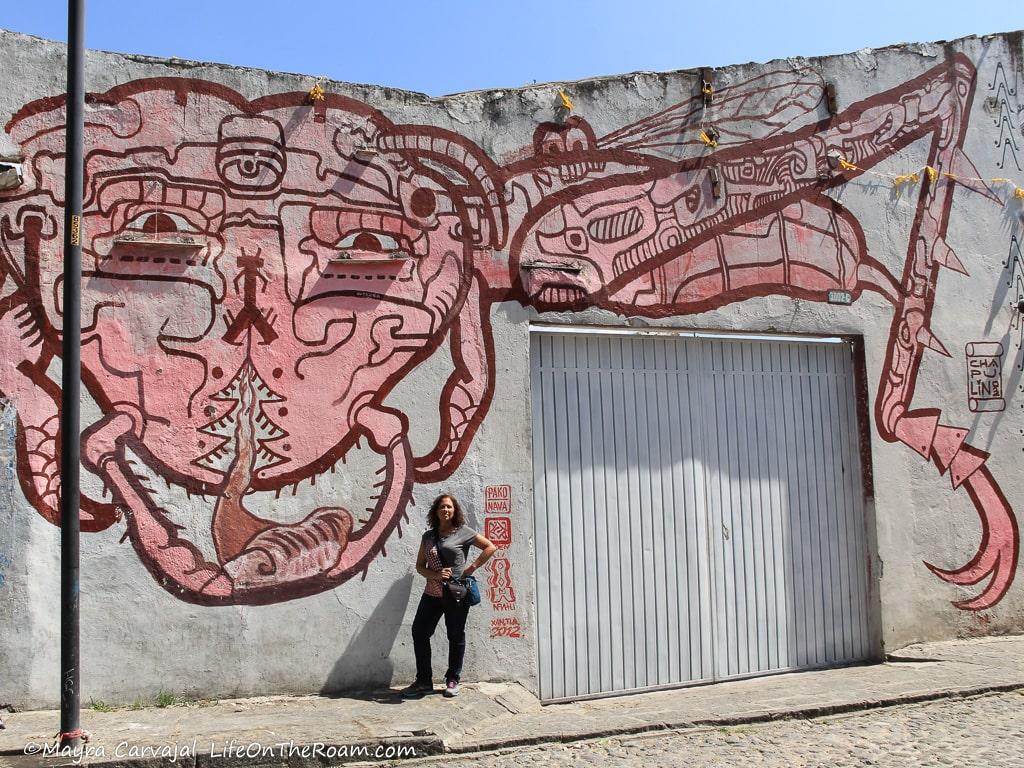
The neighbourhood of Xanenetla, one of Puebla’s oldest and with the best preserved original layout from the 16th century, was born when Spaniards relocated indigenous population to this side of the Almoloya river to build Puebla City.
In the 21st century, despite being instrumental in the construction of Puebla, Xanenetla was a forgotten place and its people were having a rough time with crime, streets filled with potholes and not enough street lights.
Someone had to do something and that someone was an organization named Colectivo Tomate. It’s formed by a group of Poblanos who stand behind the transformative power of art and encourage the participation of communities in projects that preserve their identity, culture, and traditions. Something that cities like Medellin have also experienced.
Ciudad Mural Puebla is the name of the project, with 95 murals completed so far. It’s been so successful that it has spread to other cities across Mexico.
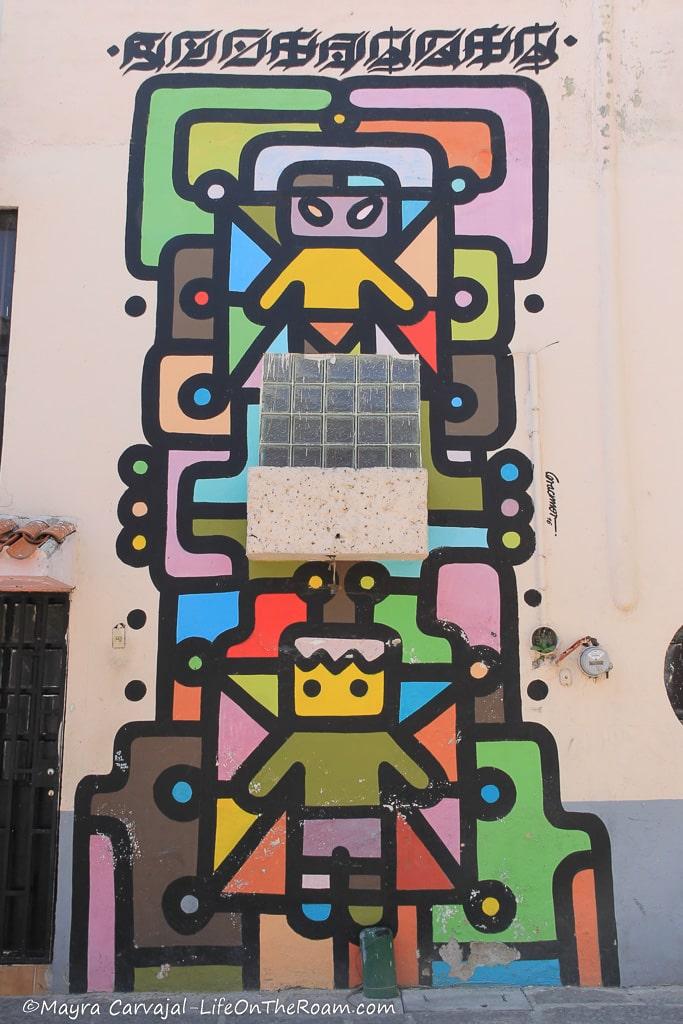
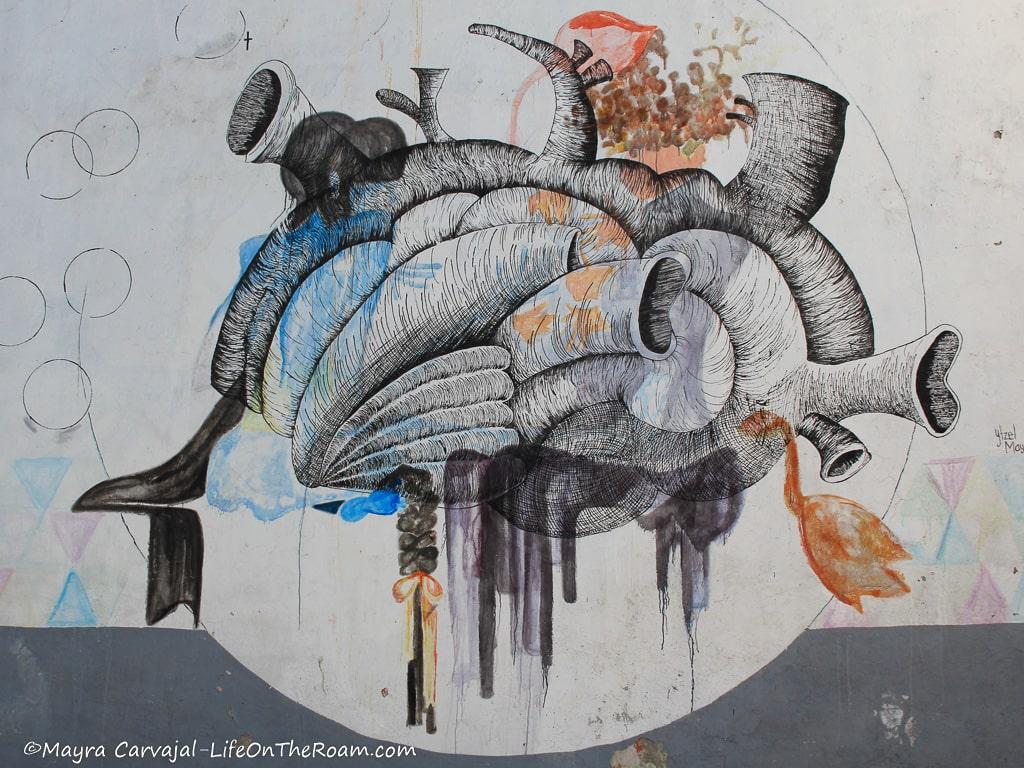
This propelled a positive change in Xanenetla. With the facelift also came improvements to the infrastructure and a reduction in crime rate.
However, there’s still work to do and crime is still a problem in this area.
As we were walking in awe from one street to the next looking at the murals, a local approached us: “Be careful, people have been robbed around here. This is not the safest part of Puebla”. I thanked him and after turning around I was wowed by another mural, and then another, and then another.
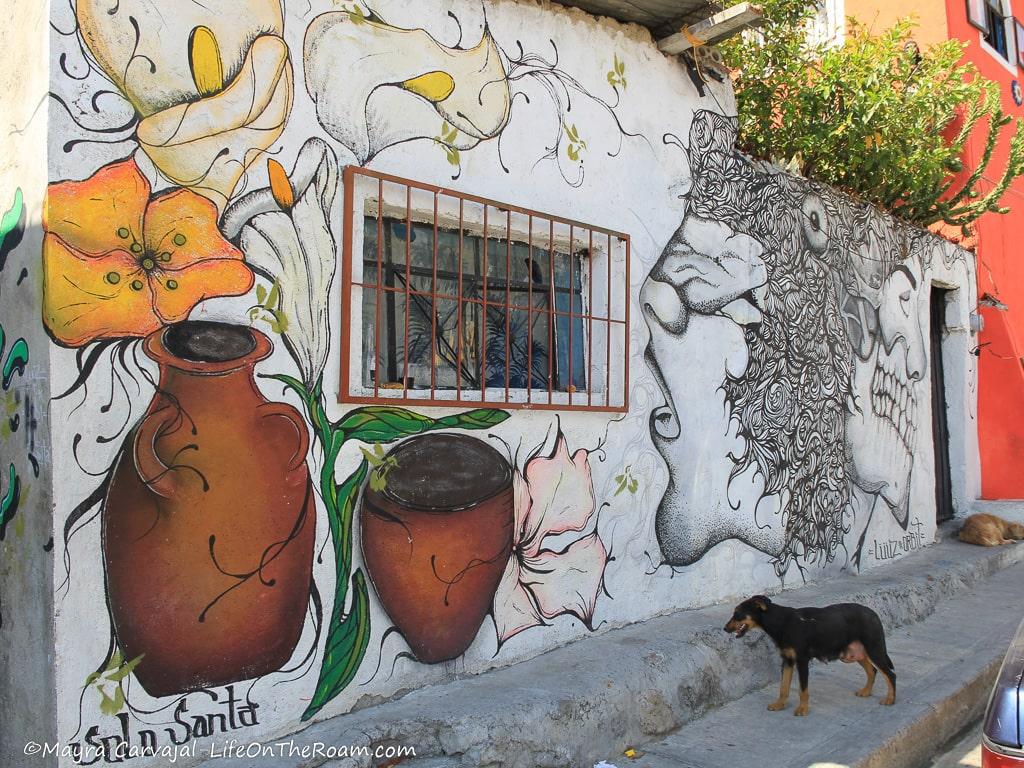
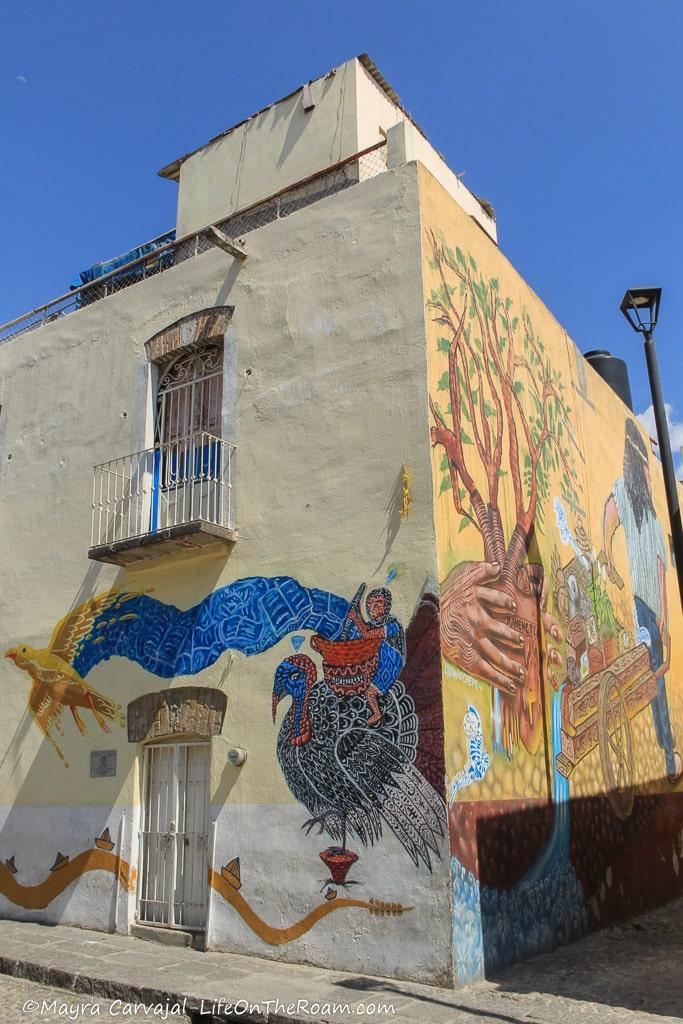
The excitement made me forget the warning and we kept going until another local approached us: “You should not be here. Robberies are common in this area and you may lose your camera and your phone”.
Well, that made it real. The lady told us to stick to the streets that are close to the entrance of the Historic Passage 5 de Mayo. She advised to check out the murals there, but to not go beyond the boundaries of Av. 28 Oriente, Xanenetla Park and Calle 4 Norte.
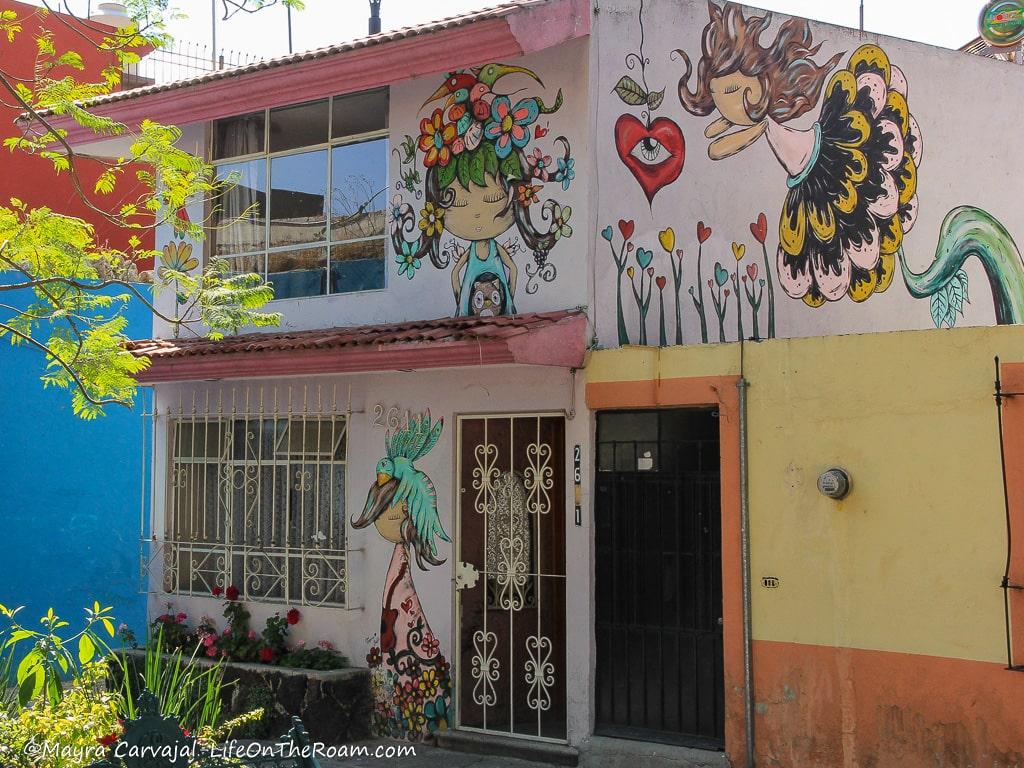
If you still want to see this fabulous sample of street art, I would follow her advice and not go deep into Xanenetla. Stay southwest of Av. 28 and don’t go by yourself.
A safer way to see the murals is to take the trolley bus tour “Barrios Antiguos”, from Turisticos Poblanos. This interesting tour departs from Puebla’s zócalo (main square) and drives through old neighbourhoods of Puebla, including Xanenetla, and you’ll be able to see some murals.
See a Mexican Wrestling Match (Lucha Libre)
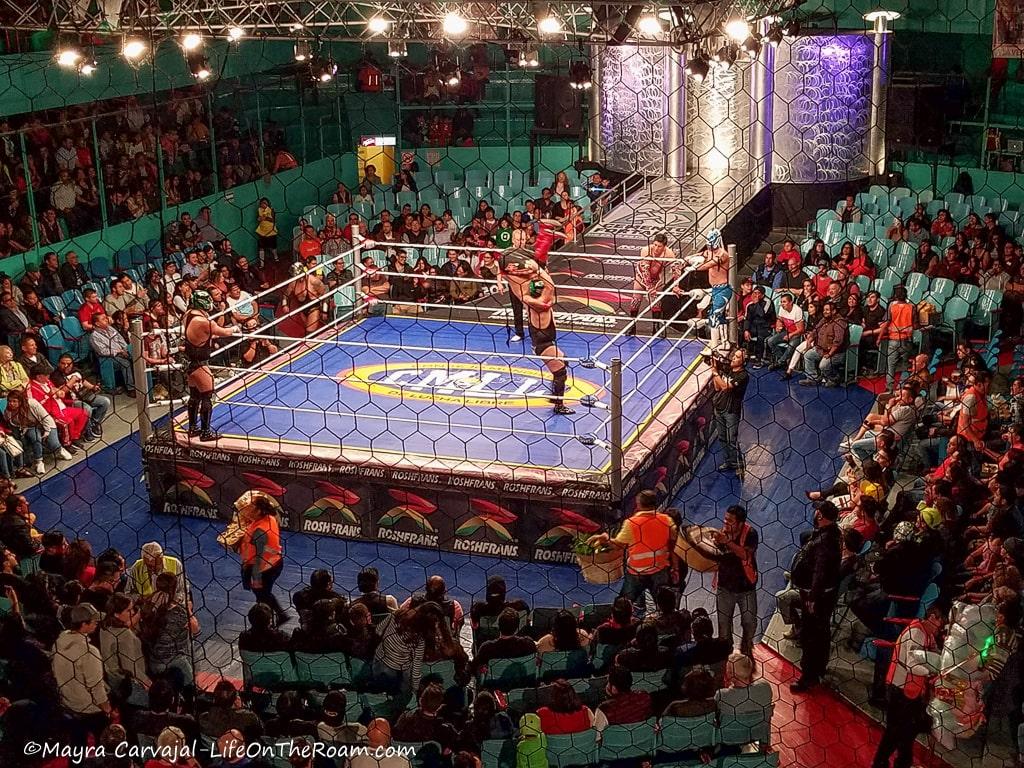
Few things are more Mexican than tacos and pouring lemon into everything. Lucha Libre, a Mexican wrestling match, is one of those things, and you can see one only six blocks from the main square, at Arena Puebla. It’s an unusual thing to do in Puebla.
Beyond the flashy costumes and masks, and the acrobatic moves performed by wrestlers with names such as “Tito the Beast”, or “The Last Son of the Villain”, the best part is how passionate audiences of all ages are about what goes on in the ring.
See Puebla’s Baroque Architecture at Night
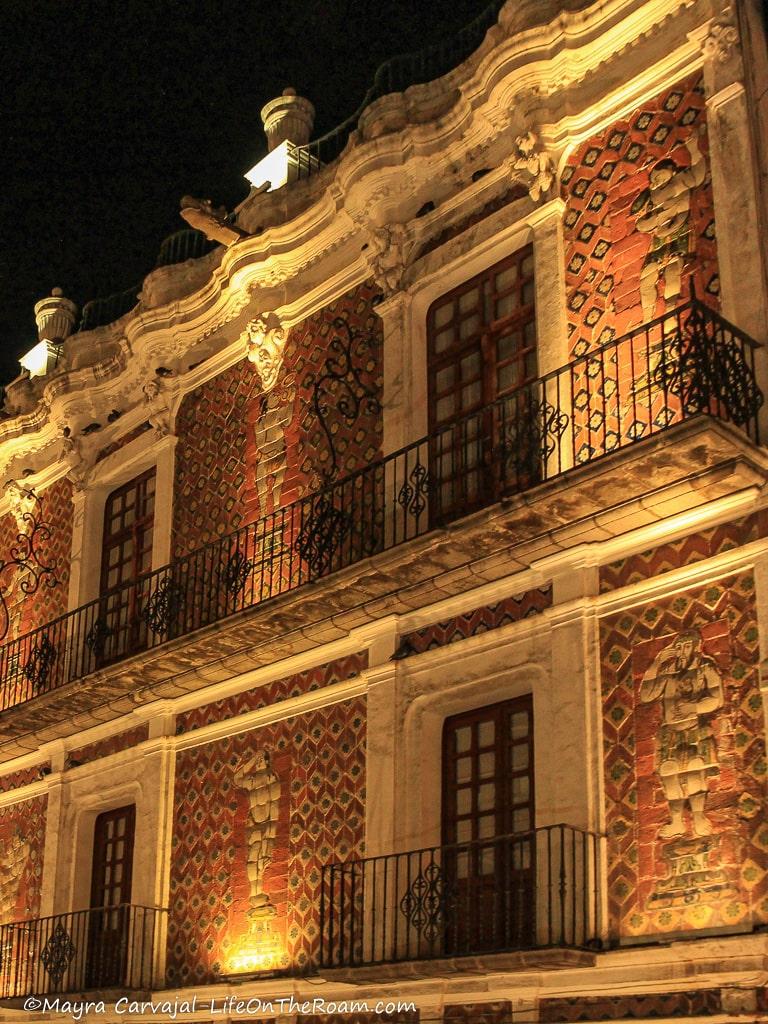
All the reliefs and intricacy typical of the Baroque take a new dimension when they’re lit up after sunset. It’s a great opportunity to appreciate the details of the gorgeous buildings of Puebla’s Historic Centre, and see monuments and fountains bathed in colours.
Have some excellent cocktails at the terrace of Voco Royalty Hotel and enjoy an unbeatable view of Puebla’s Cathedral lighting while you see the busy life of the main square after dark.
Voco Royalty Hotel: a good option if you want to stay right in the centre of Puebla, next to the zocalo. Rooms are modern, with AC, WiFi and a flat-screen TV. Some have a desk and some have a balcony.
Stay at Voco, with a rating of 8.8 based on more than 280 reviews.
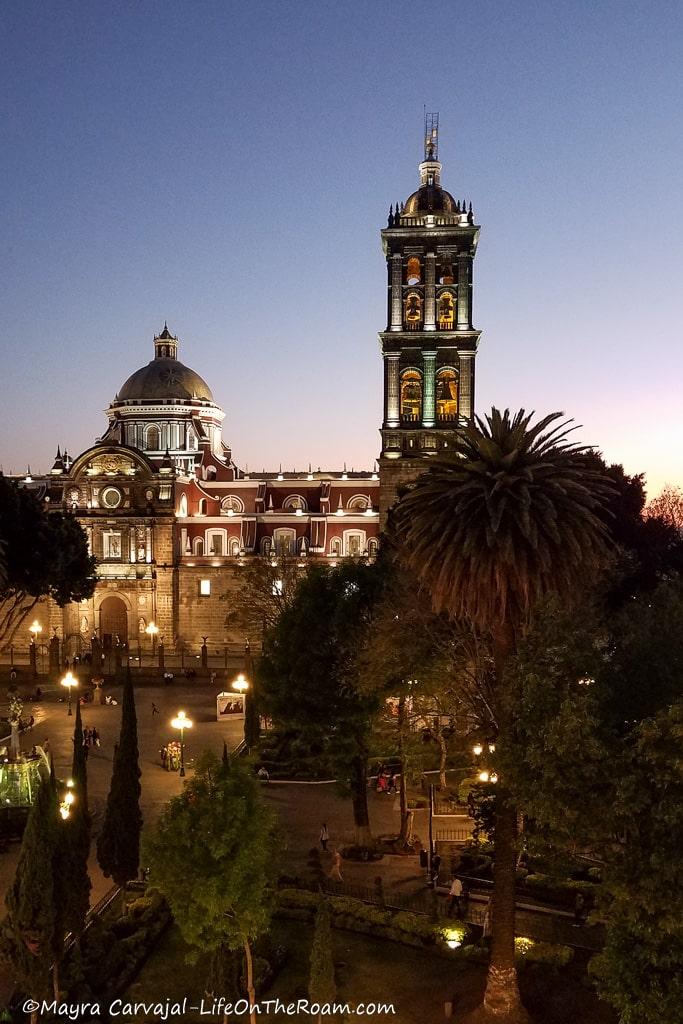
You can then take a cantina tour to visit Puebla’s traditional bars at night.
Don’t feel like walking around town? Catch one of the tour buses you’ll find around the main square and see the beautiful architecture along the route from the comfort of your seat.
And if you visit during the weekend remember to check out the light show on the Cathedral.
How to Get to Puebla from Mexico City
Although Puebla has an airport – the Hermanos Serdan International Airport (PBC)-, international and domestic direct flights are limited. And there are no direct flights from Mexico City.
However, you can fly into Mexico City and then ride a bus to Puebla that leaves you in CAPU (Puebla’s main bus station). From there, it’s a 15 to 20-minute cab ride to the Historic Centre.
The most comfortable ride is with the ADO line, in the ADO buses (the AU units are a little bit cheaper, but not as nice).
From the airport, depending on your departure time and departure point, it’s a 2.25 to 3-hour trip.
If you’re already in Mexico City you can depart from:
Mexico TAPO (the station located on the east side of the city), near the San Lázaro subway station.
Central Mexico Norte (on the north area), near the Autobuses del Norte subway station.
Mexico Taxqueña (in the south area), near the Tasqueña subway station.
Buses depart frequently. For schedules, download the ADO app on your phone (and make sure you’re heading to the right station).
How Many Days Should I Spend in Puebla?
Although many people visit Puebla as a day trip from Mexico City, I recommend spending at least three days here. Puebla is worth visiting for several days as there are enough things to do in the city to keep you busy and considering that you’ll spend at least two hours on the road (each way), you’ll barely scratch the surface (better than nothing, though).
If you plan to take day trips from Puebla to nearby magical towns like Cholula and Atlixco, I would plan for five days.
Puebla is a lesser-known destination in Mexico that deserves more than a day trip from the capital. You’ll also find other nearby cities and towns that are worth visiting.
YOU MAY ALSO WANT TO READ
BOOKING FLIGHTS AND ACCOMMODATIONS
Book your flight without losing your shirt
We check Momondo to find great deals to book our flights. Also, check Great Escape: it combines the listings from Expedia, Kiwi, Kayak, (and Skyscanner on the premium service) to find the best airfares.
To find a place to stay for less
Booking.com: this site combines everything under the sun. You’ll find hotels, apartments, B&B, hostels, rooms, etc., with all sort of filters to make your search a breeze.
Hotwire: the first site I check when we plan to stay at a hotel for a few nights. You can save anything from 20% to 60%. Use the search filter to find what you want and you’ll end up with three listings that match your criteria. You’ll know which one you’ll get after you book. If you can handle a little bit of uncertainty you can score big savings.
House Sitting: you take care of people’s pets and house for free while staying for free. It’s the closest thing to experiencing a place “like a local”. But it comes with responsibilities… Are you an animal lover? It may become your new way to travel.
To get travel insurance
SafetyWing: travel medical insurance that gives us peace of mind knowing that we’re covered in case of emergency. It’s convenient, affordable, and suitable for digital nomads who spend a long time outside their home country.
Check the full list of travel resources on my Resource Page for more options and savings
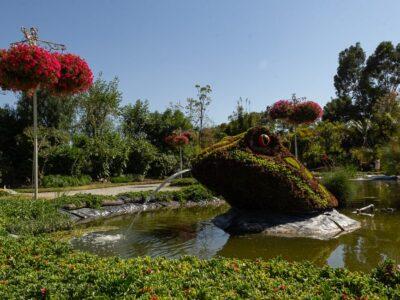
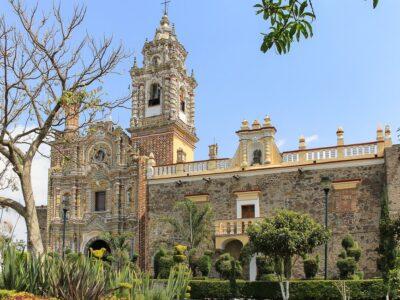
Wow! What a fabulous place to visit. Thanks for all the travel and accommodation tips!
Glad you enjoyed the post and I hope you visit Puebla soon.
Beautiful post! Love the pics, really captured the town.
Thank you!
Great post!
Thanks!
This is such a great reference for anyone traveling. I love the church, it looks stunning!!
It is stunning. In the past it was named the 8th wonder of the new world many times.
It’s so beautiful there. You captured the essence so well in your photos.
Thank you! Puebla is a beautiful city.
Great information and wonderful sights to see I love all you have mentioned though the library and The Nuremburg Chronicle would be a treat to see…and street markets…who can resist these
Street markets are so colourful in Mexico. A cultural experience. The Palafoxiana library has several rare books. If you’re a book worm you’ll find this place very interesting. If not, you’ll still enjoy the beautiful woodwork. And the gorgeous door!